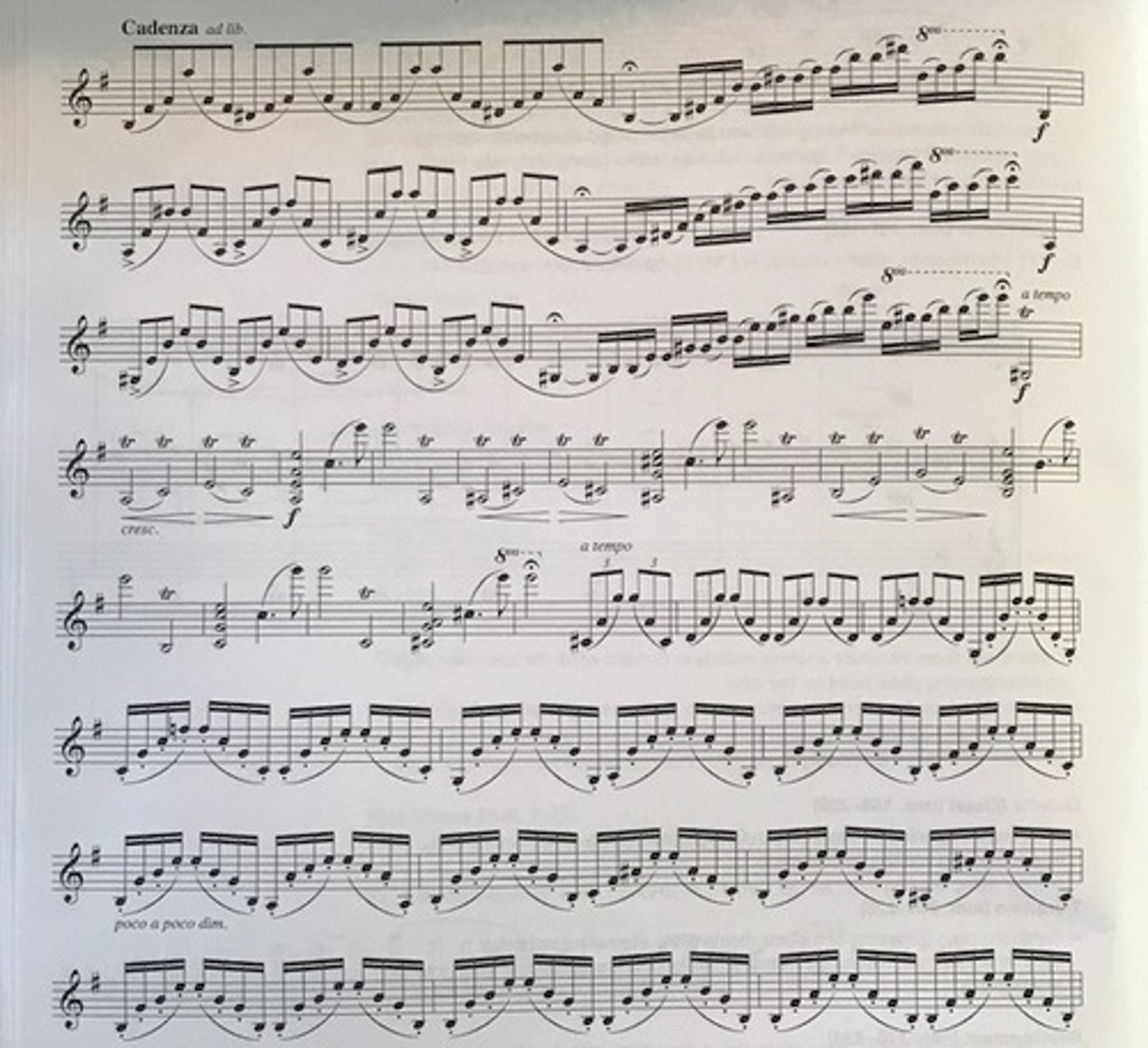ARCT History Compositions
1/74
There's no tags or description
Looks like no tags are added yet.
Name | Mastery | Learn | Test | Matching | Spaced |
|---|
No study sessions yet.
75 Terms
Schubert, "Trout" Quintet, 4th mvt: Theme
- scored for strings without piano
- melodic line is played by the violin
- homophonic texture
- binary form
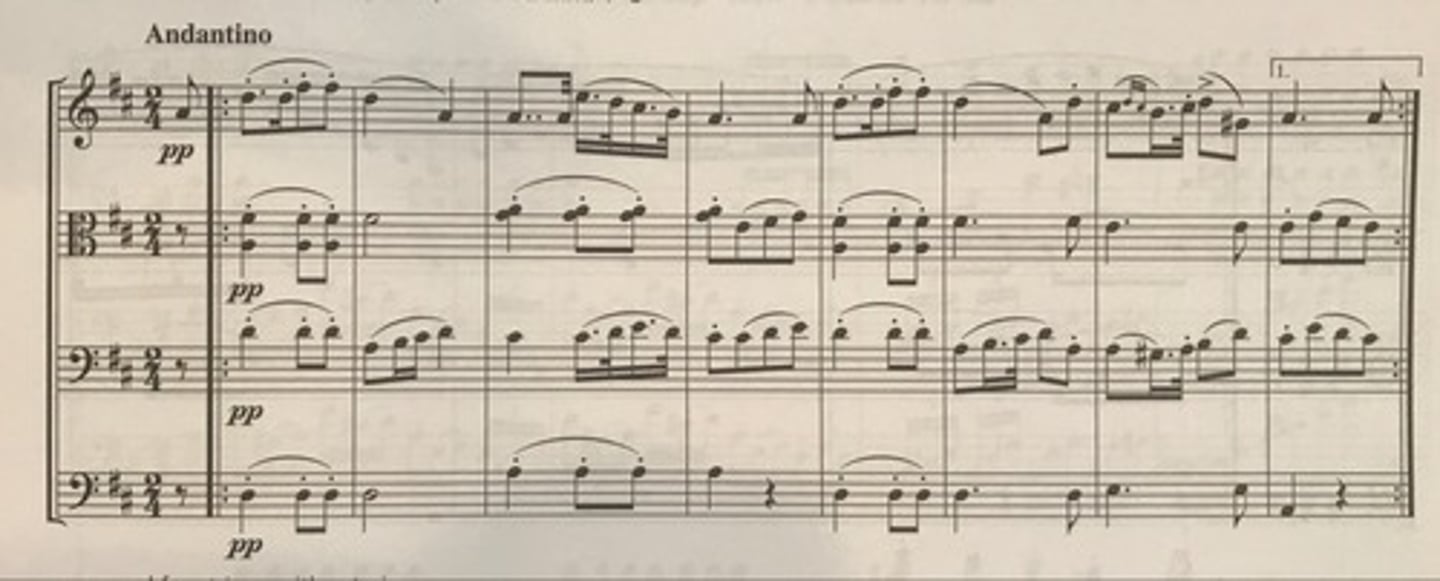
Schubert, "Trout" Quintet, 4th mvt: Variation 1
- theme is played by the piano (embellished with trills) in both hands separated by an octave
- double bass plays pizzicato
- violin and cello play triplet figure in imitation
- musical character is graceful and elegant
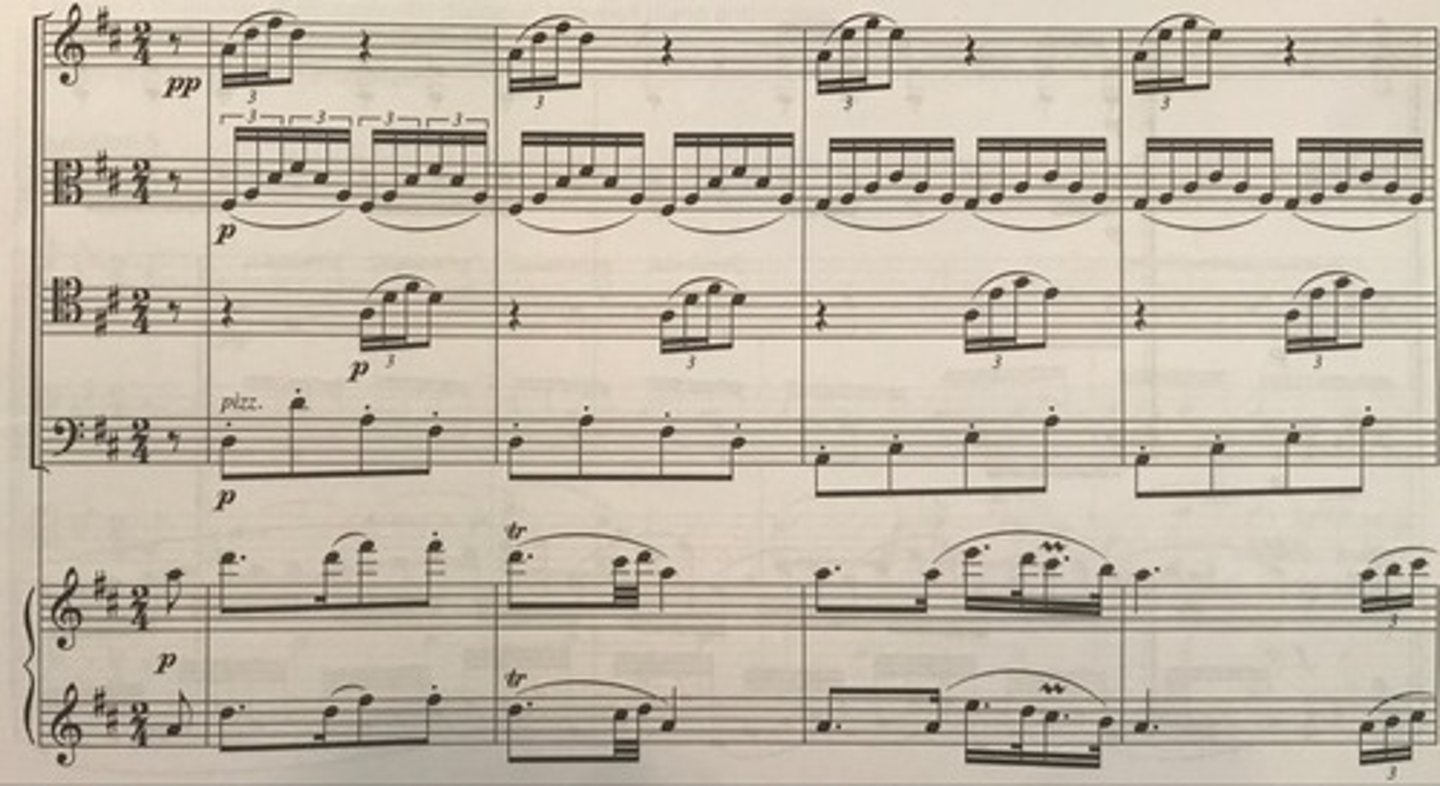
Schubert, "Trout" Quintet, 4th mvt: Variation 2
- theme is played by the viola
- a countermelody, in sixteenth-note triplets, is played by the violin
- piano imitates fragments of the theme
- musical character remains lighthearted and elegant
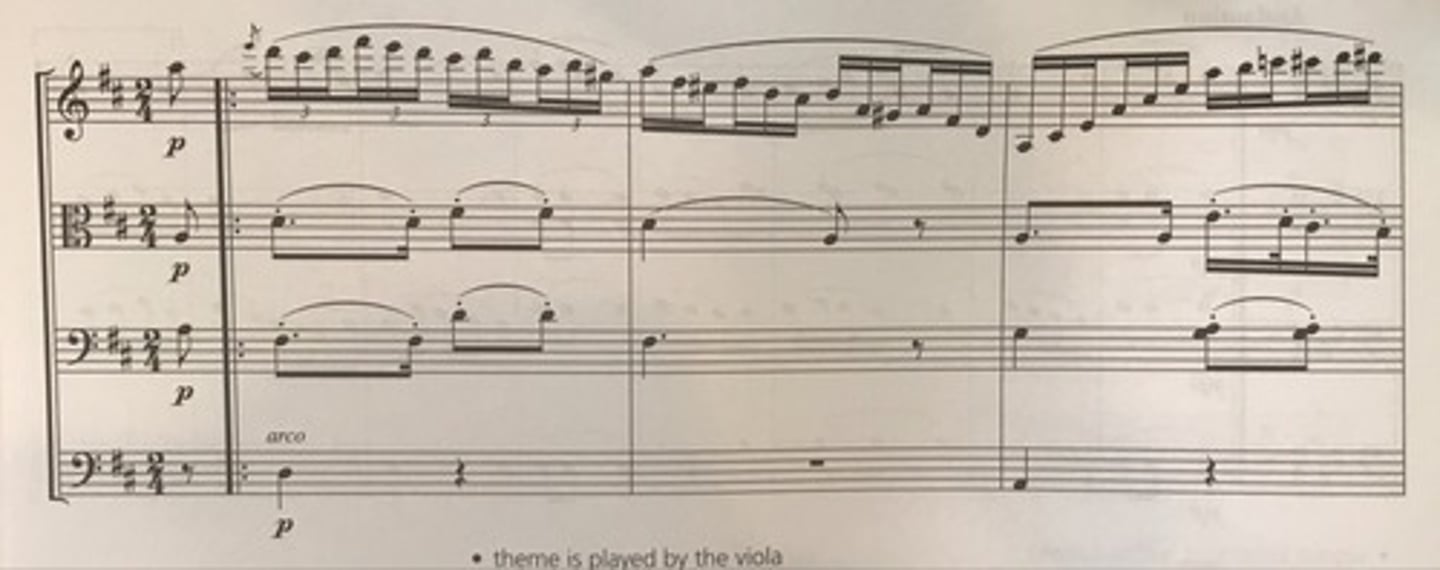
Schubert, "Trout" Quintet, 4th mvt: Variation 3
- theme is played by double bass, resulting in a comical effect
- piano plays a virtuosic accompaniment ot the theme
- the violin and viola play a syncopated 16th-note accompaniment
- musical character is humorous and ironic
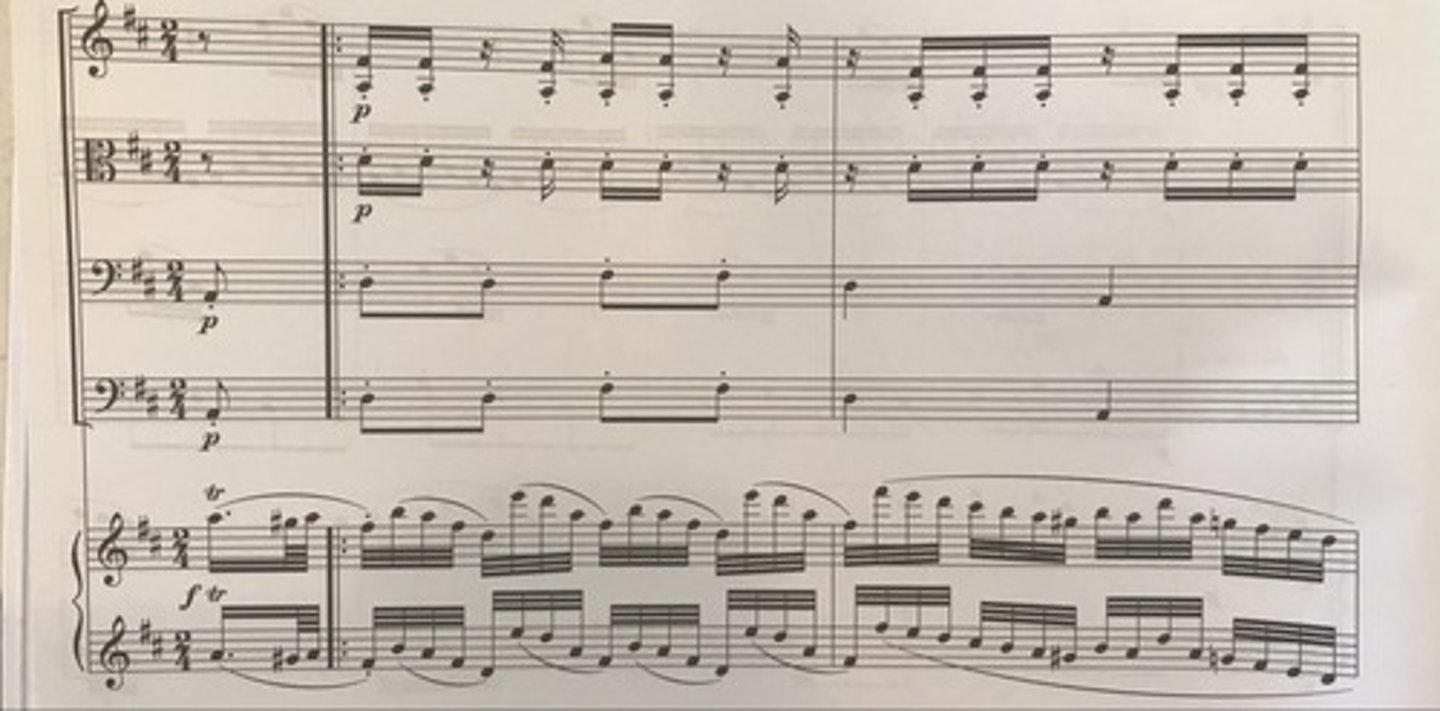
Schubert, "Trout" Quintet, 4th mvt: Variation 4
- theme is shared by all instruments; dialogue between piano and strings
- begins in D minor; abrupt changes of dynamics
- more dramatic and forceful effect
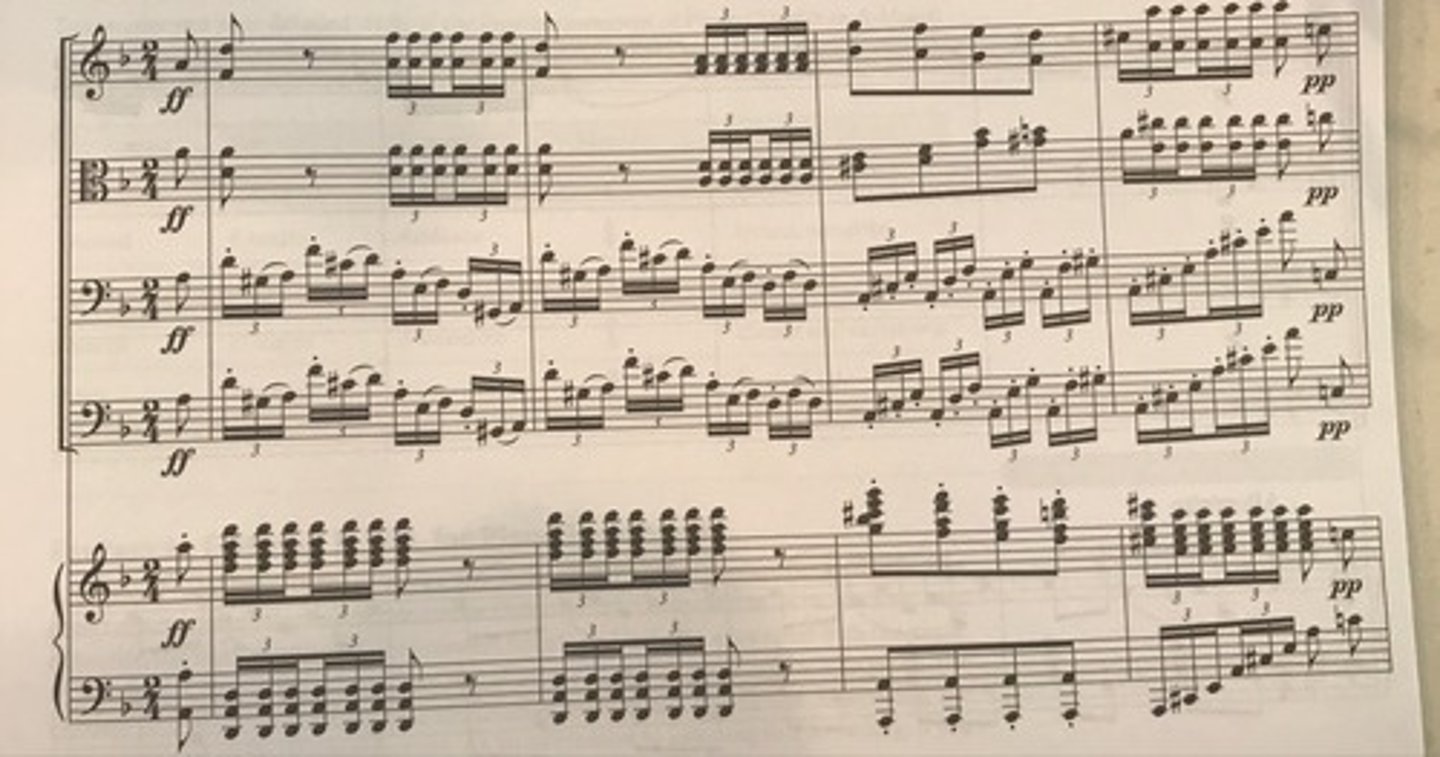
Schubert, "Trout" Quintet, 4th mvt: Variation 5
- theme is played by the cello
- begins in Bb major; cello plays the theme in jagged dotted rhythms
- piano responds, imitating the rhythmic figure
- broad and lyrical
- transition prepares and leads into Variation 6
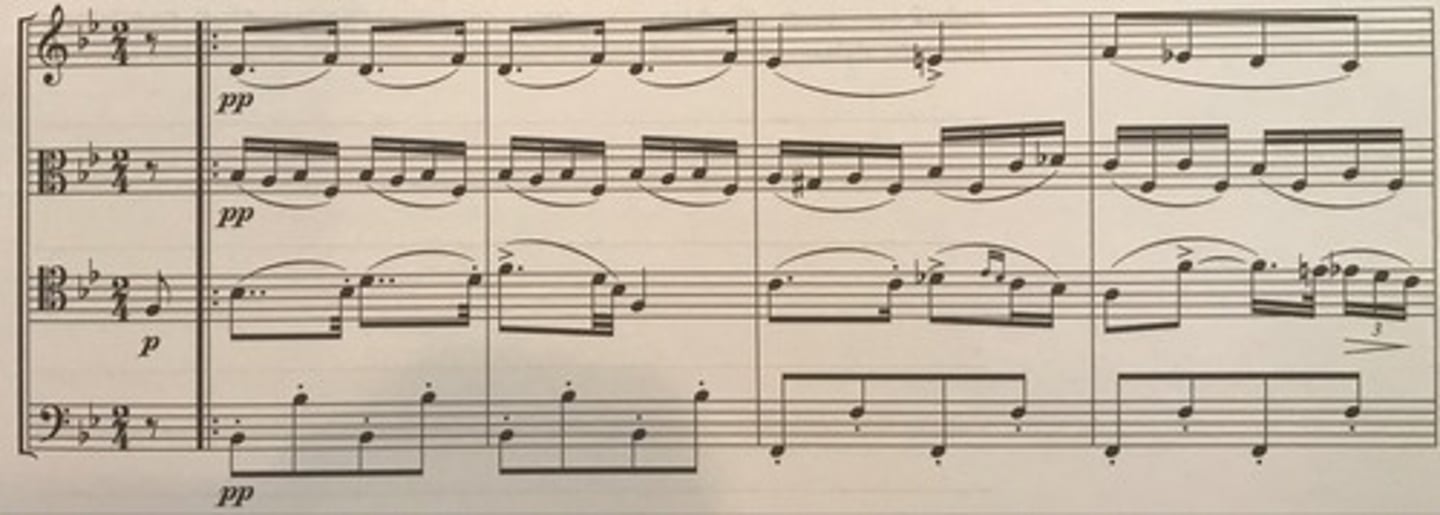
Schubert, "Trout" Quintet, 4th mvt: Variation 6
- theme is played by the violin
- piano plays the 16th-note triplet accompaniment drawn from the original song
- tempo changes to Allegretto
- a gentle coda (as in the original song) brings the movement to a quiet close
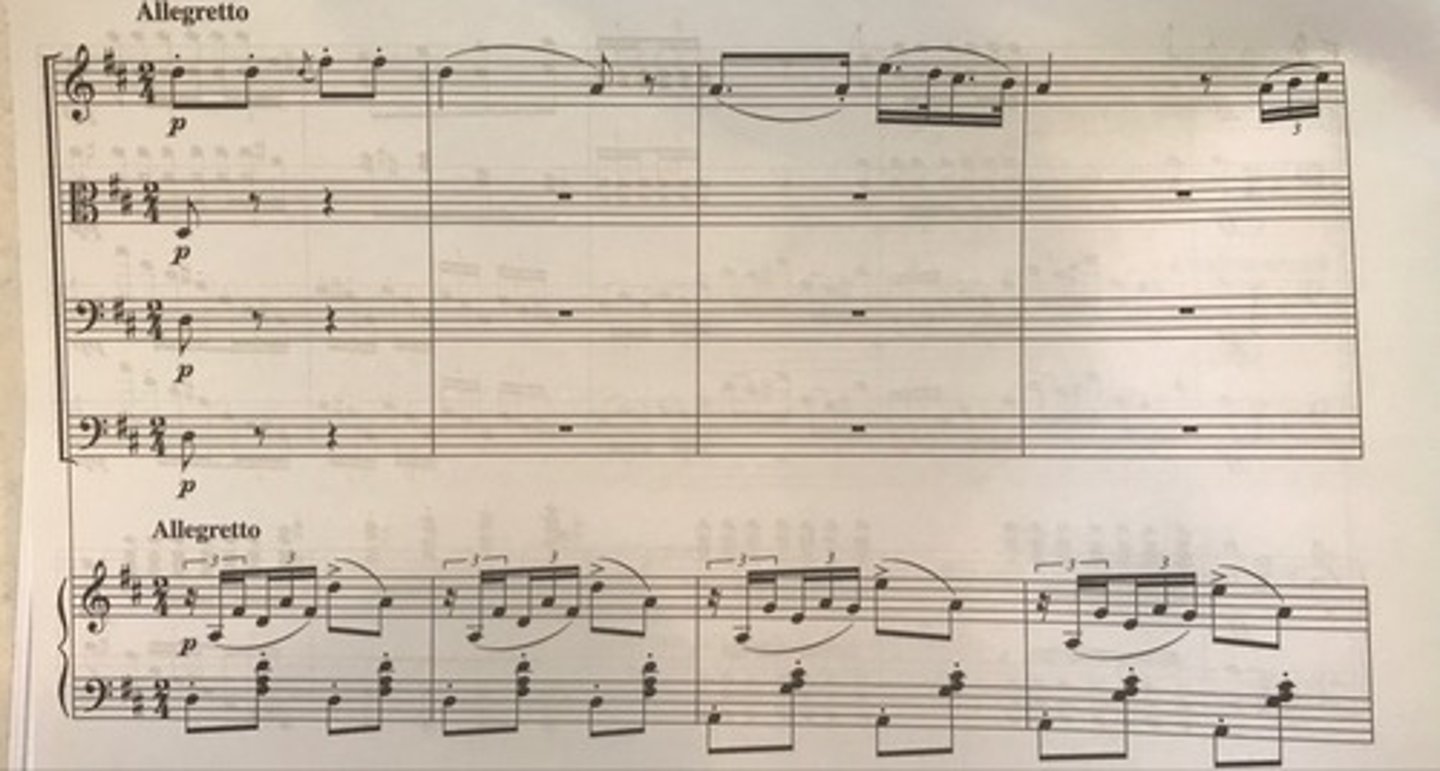
Mendelssohn, Violin Concerto in E Minor, op. 64, 1st mvt: Bridge Theme (Transition)
- soloist leads with angular melody followed by electrifying passagework involving string crossings, arpeggiated figures, and double stops in rising chromatic thirds
- modulates to G major (relative major)

Mendelssohn, Violin Concerto in E Minor, op. 64, 1st mvt: Second Theme
- clarinets and flutes introduce a serene melody in G major while the solo violin plays an accompanying pedal poing on the tonic
- the melody is based on a repeated-note motive that is treated sequentially
- marked pp and tranquillo
- solo violin reiterates the first theme
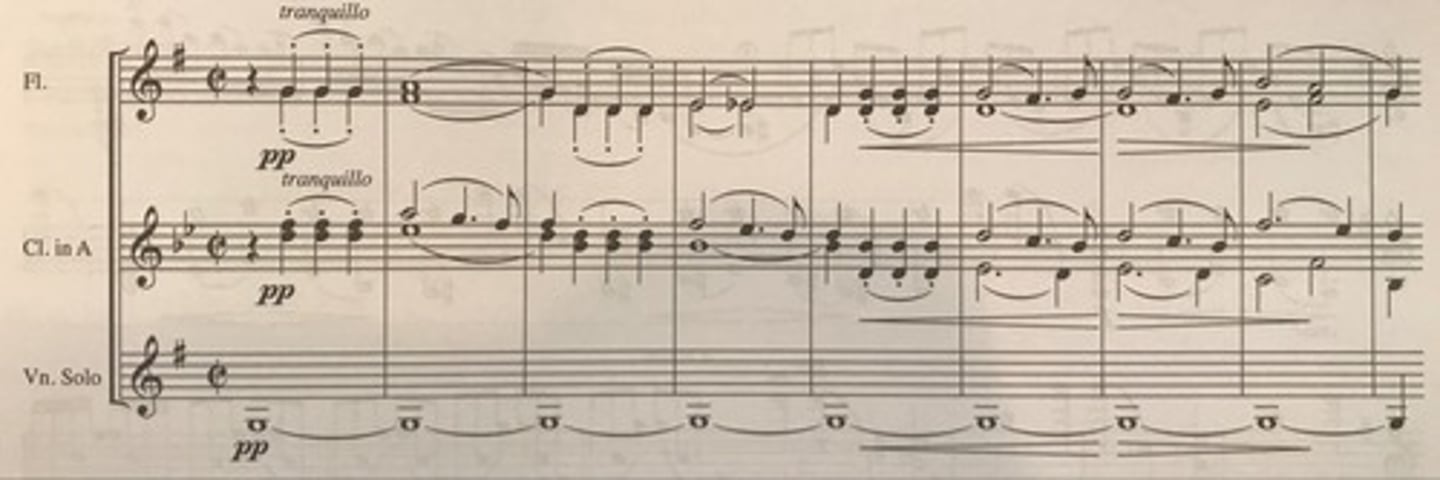
Mendelssohn, Violin Concerto in E Minor, op. 64, 1st mvt: First Theme
- after a very brief orchestral introduction, solo violin enters with a broad melody outlining the tonic triad
- virtuosic writing for the solo violin includes rapid passagework, triplets, and octaves
- first theme restated by orchestra.

R. Schumann, "Eusebius": Theme A
- marked sotto voce and senza pedale
- the right hand weaves a delicate line played in septuplets, thereby establishing a cross rhythm with the half and quarter notes in the left hand and an improvisatory, nostalgic character
- the opening phrase (repeated, with subtle changes in accompaniment) ends on a tonic chord in second inversion, imparting a wistfulness to the passage.

R. Schumann, "Eusebius": Theme B
- grows out of the opening material
- the nostalgic and dreamy atmosphere is heightened by increased chromaticism
- cross rhythms become even more sophisticated; for example, in m. 11 (5+3 in the RH against 3 in the LH), enhancing the sense of rhythmic freedom and flexibility.

R. Schumann, "Eusebius"
- Schumann alternates theme A and theme B, subjecting them to subtle variation, including expanded range, octave reinforcement, and denser LH accompaniment
- piece ends with the unexpected second-inversion tonic chord

R. Schumann, "Florestan": mm. 1-2 (opening)
- opens with an aggressively angular RH melody
- the opening notes A, Eb, C and B (A-S-C-H) form one of the musical cryptograms that are woven into this collection
- dissonant harmonies draw heavily on diminished 7th chords
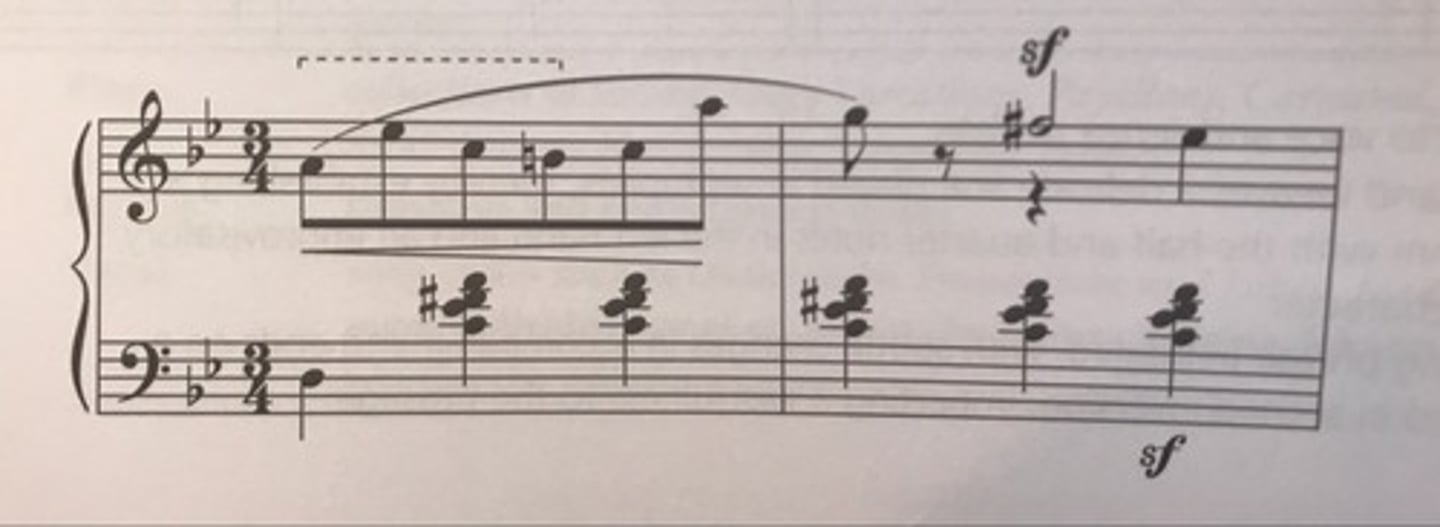
R. Schumann, "Florestan": mm. 47-58 (final passage)
- the final passage is marked accelerando and rinforzando
- intensity is increased int he closing measures through fragmentation of the theme
- the meldoy is first broken into two-note fragments, then played as disnjunct staccato octaves.
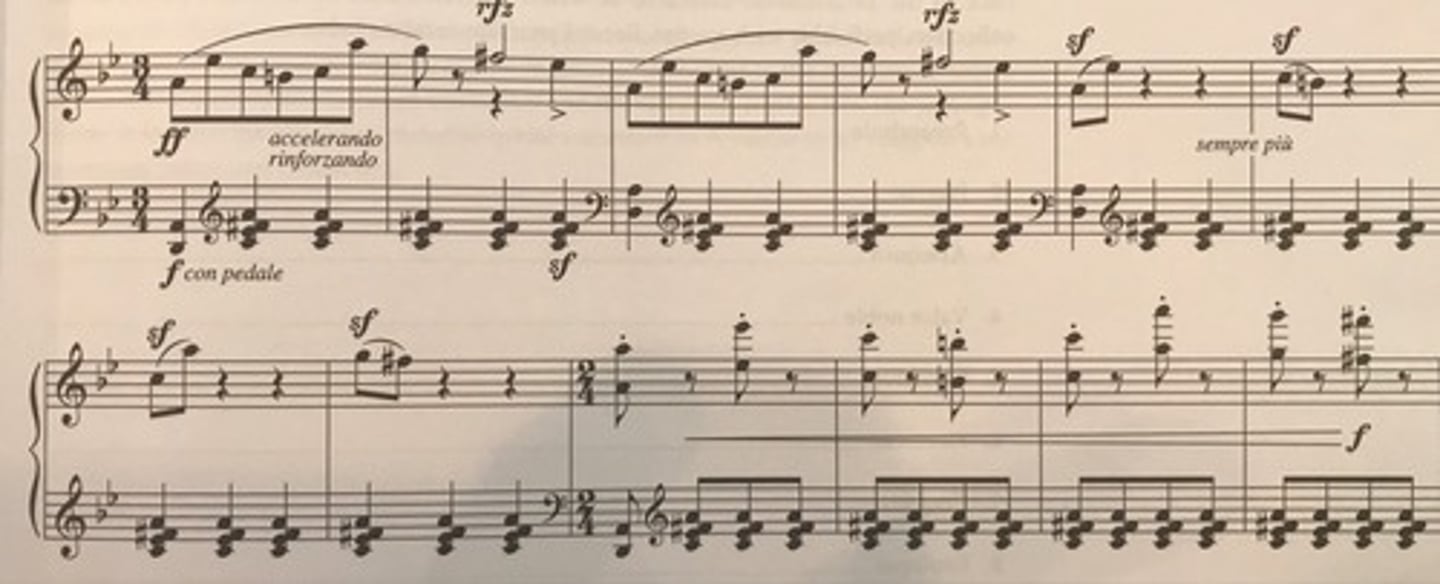
C. Schumann, Liebst du um Schonheit, op. 12, no. 4: Intro and Verse 1
- opens with a brief piano introduction
- simple diatonic harmonies establish Db major (tonic-dominant)
- the melody opens iwht an ascending P4; each verse bbegins with this motive and is structured as a contrasting period
- the mostly stepwise melodic motion projects the simple sentiment of the text
- text translates, "If you love for beauty, oh, do not love me!"
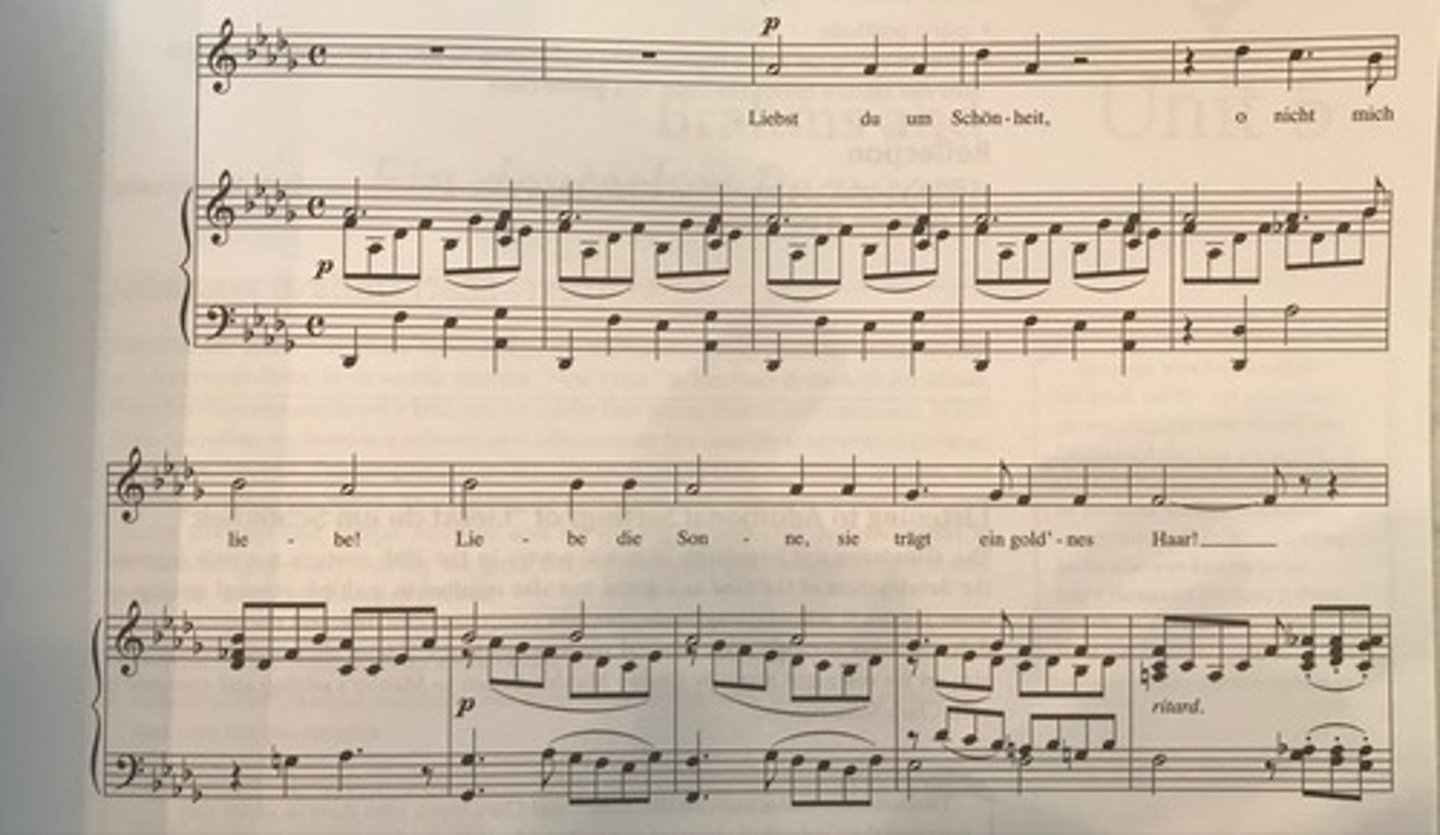
Brahms, Ein Deutsches Requiem, op. 45, 4th mvt: Section A
- flutes and clarinets begin softly with an inverted statement of the opening soprano melody, marked dolce
- word painting is achieved with an ascending line, rising upward, as if to heaven
- sopranos trace a broadly arched, conjunct melody
- principally homorythmic texture
- German text translates to, "How lovely is Thy dwelling place, O Lord of hosts!"

Brahms, Ein Deutsches Requiem, op. 45, 4th mvt: Section B
- opens with imitative passage: the melodic idea is presented in each voice from basses to sopranos in turn, emphasizing the words "verlanget und sehnet" ("longs and yearns"); resembles a fugal exposition
- dramatized by corresponding crescendo
- more estatic homorhythmic expression of the text follows, climaxing in the high registers; accompanied initially by delicate arpeggiated pizzicato figures giving way to fp accents
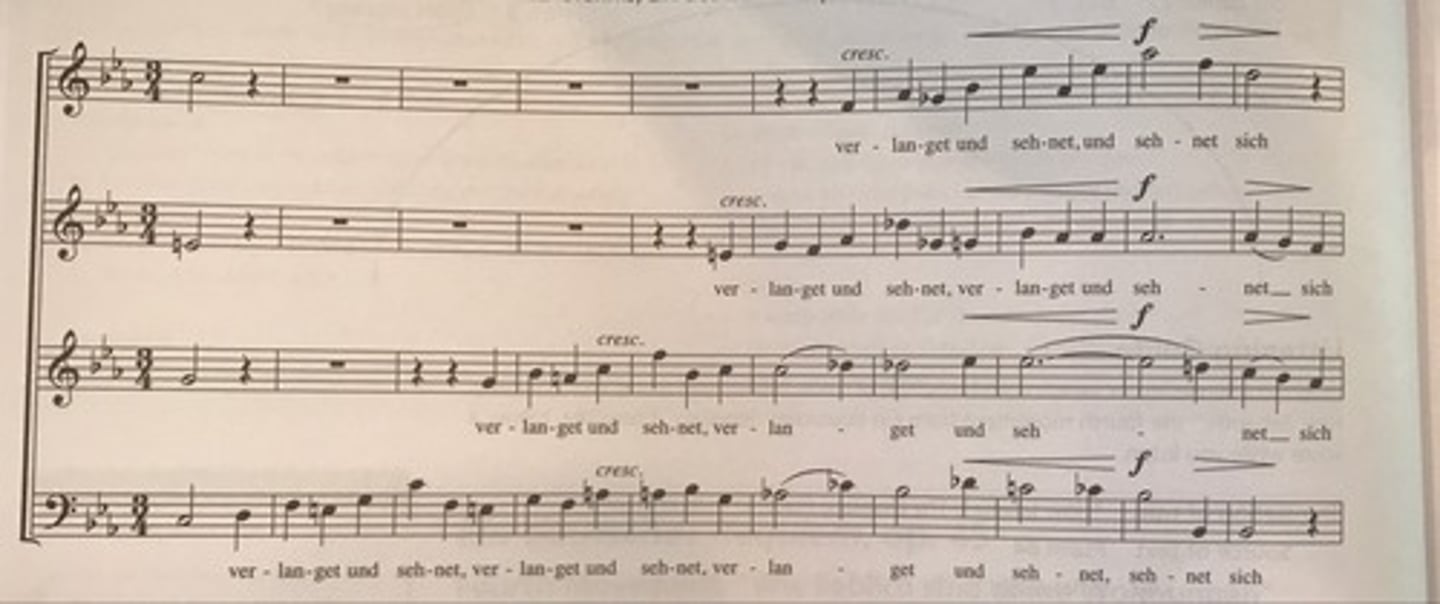
Liszt, La Campanella: Introduction and Section A
- after a brief introduction, the main theme is played by the RH
- pedal point on high D# represents the bell
- wide leaps in RH part add to technical difficulty
- this section is repeated with embellishment

Liszt, La Campanella: Section B
- in B major; builds sequentially in an ascending pattern
- increased chromatic harmony
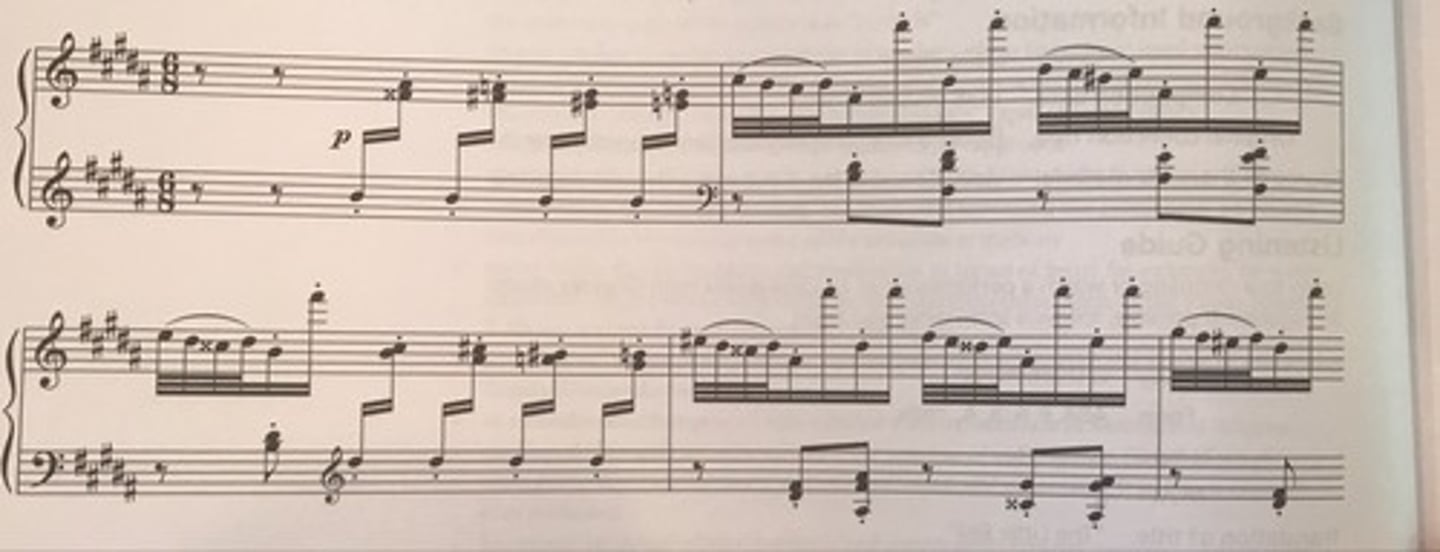
Brahms, Ein Deutsches Requiem, op. 45, 4th mvt: Section C
- robust quality and forte dynamics convey the joyful sentiment of the text
- imitative (fugal) texture resembling contrapuntal procedure of Section B
- climax on "Die loben Dich immerdar' ("They will always be praising thee") emphasized by composer's signature use of hemiola
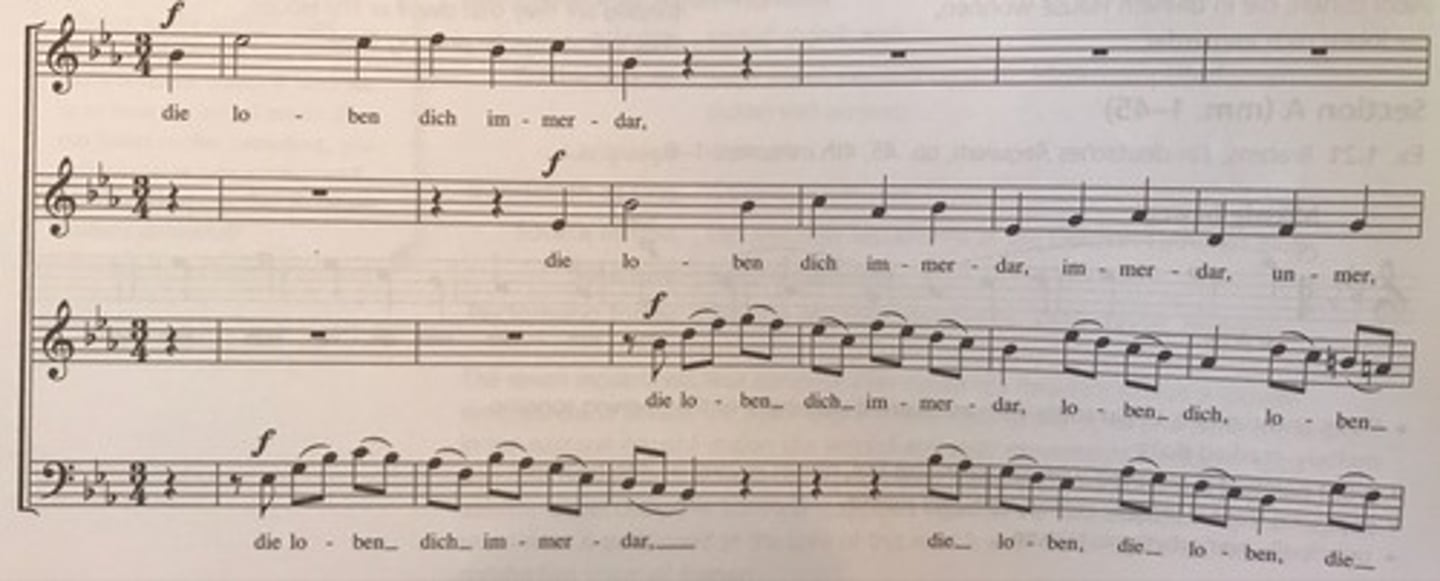
Verdi, "Invitato a qui seguirmi..." from La traviata, act 2, scene 2: Violetta and Alfredo's exchange
- an ominous Bb diminished seventh chord played by full orchestra ff introduces Violetta's agitated solo line, beginning with the opening line of her recitative
- with a flurry of 16th-notes, the first violins announce Aflredo's entrance
- a passionate exchange between Violetta and Alfredo unfolds

Verdi, "Invitato a qui seguirmi..." from La traviata, act 2, scene 2: Violetta and Alfredo's exchange
Alfredo: If I kill him, you will lose lover and protector at a single blow. Does such fate not terrify you?
Violetta: But if he should be the killer? That is the only thought that puts the fear of death into me.
- doubled by woodwinds, Alfredo sings a broadly arched phrase suggesting both his jealousy and reckless bravado

Verdi, "Invitato a qui seguirmi..." from La traviata, act 2, scene 2: Alfredo's Denunciation of Violetta
Alfredo: For this woman lost all she possessed. I was blind, a wretched coward, I accepted it all. But it is time now for me to clear myself from debt. I call you all to witness here that I have paid her back!
- the simplicity of the key (C major) underscores Alfredo's self-righteousness; it stands in marked contrast with what follows

Verdi, "Invitato a qui seguirmi..." from La traviata, act 2, scene 2: The Guests' Reaction and Response
All: What you have done is shameful! So to strike down a tender heart! You have insulted a woman! Get out of here! We've no use for such as you! Go!
- with a sudden shift to minor mode, the unison chorus and orchestra convey furious disapproval of Alfredo's actions

Verdi, "Invitato a qui seguirmi..." from La traviata, act 2, scene 2: The Guests' Reaction and Response
Germont: A man who offends awoman, even in his anger, merits nothing but scorn. Where is my son? I see him no more in you, Alfredo!
- Germont passionately condemns his son's callous behavior toward Violetta

Verdi, "Invitato a qui seguirmi..." from La traviata, act 2, scene 2: The Guests' Reaction and Response
Alfredo: What have I done? Yes, I despise myself! Jealous madness, love deceived, ravaged my soul, destroyed my reason. How can I ever gain her pardon? I would have left her but I could not; I came here to vent my anger, but now I have odne so wretch that I am, I feel nothing but deep remorse!
- Alfredo sings in short, breathless phrases, reflecting his remorse and agitation

Verdi, "Invitato a qui seguirmi..." from La traviata, act 2, scene 2: The Guests' Reaction and Response
Violetta: Alfredo, how could you understand all the love that is in my heart? How could you know that I have proven it, even at the price of your contempt? But the time will come when you will know, when you'll admit how much I love you. God save you from all remorse! Even after death, I shall still love you!
- Vioeltta sings a caressing bel canto melody that soars above the soft murmurings of the crowd.

Wagner, "Der Augen leuchtendes Paar" from Die Walkure, act 3, scene 3: Wotan's Farewell to Brunnhilde
- low strings begin to weave their magic spell as they play the "slumber" Leitmotif in and ostinato-like manner
- the "slumber" Leitmotifis woven symphonically throughout the score

Wagner, "magic sleep" Leitmotif from Die Walkure, act 3, scene 3: Wotan's Farewell to Brunnhilde
- as Wotan kisses Brunnhilde, the "magic sleep" Leitmotifis played by harp and woodwinds; its chromatic harmonies move in contrary motion

Wagner, "spear" Leitmotif and "Loge" Leitmotif from Die Walkure, act 3, scene 3: Wotan's Farewell to Brunnhilde
- the "spear" Leitmotif is a bold, descending figure, played forcefully by the trombones; Wotan uses his spear (symbol of his power) to summon Loge (god of fire)
- string tremolos accompany Wotan's invocation

Wagner, "magic fire" Leitmotif from Die Walkure, act 3, scene 3: Wotan's Farewell to Brunnhilde
- as flames begin to encircle the sleeping Brunnhilde, they are accompanied by the "magic fire" Leitmotif
- staccato 16th-notes in the woodwinds suggest the flickering flames

Wagner, "Siegfried" Leitmotif from Die Walkure, act 3, scene 3: Wotan's Farewell to Brunnhilde
- without naming him, Wotan prophesies Brunnhilde's rescue by Siegfried (in the final opera)
- Wotan is accompanied byt eh "Siegfried" Leitmotif, an upward-thrusting theme played by the brass
- as Wotan leaves the sleeping form of his mortal daughter, the "slumber" and "magic fire" Leitmotifs gently combine; the curtain falls.

Tchaikovsky, Romeo and Juliet Overture: First Theme ("Feud" Theme)
- Allegro giusto
- Common Time
- B minor
- an agitated, syncopated melody is played f by the cellos and answered by piccolo
- cymbals crash against driving strings

Tchaikovsky, Romeo and Juliet Overture: Theme 2a ("Love" Theme)
- Db major
- Common Time
- stated broadly by English horn and muted violas

Tchaikovsky, Romeo and Juliet Overture: Introduction
- Andante non tanto quasi moderato
- Common Time
- begins in F# minor

Tchaikovsky, Romeo and Juliet Overture: Theme 2b ("Juliet" Theme)
- a gently pulsating melody is played pp by the muted violins

Mahler, Symphony No. 4 in G Major, 4th mvt: Orchestral Introduction (Principal Theme)
- marked Sehr behaglich (Very comfortably)
- begins with clarinet very softly (ppp) playing a folk-like melody built around the tonic chord
- the lyrical melody is characterized by dotted figures and grace notes
- the harp, often associated with angels and heaven is heard gently in the background throughout this movement

Mahler, Symphony No. 4 in G Major, 4th mvt: Verse 1
- mezzo-soprano opens with a more expansive version of the principal theme
- undulating melisma emphasizes the word "heaven"
- the singer is instructed to "sing with a childlike and serene expression without parody"
- harp and pizzicato strings add support along with woodwinds and triangle

Mahler, Symphony No. 4 in G Major, 4th mvt: Verse 3
- mezzo-soprano sings a variant of the principal theme
- when describing the bounties of heaven, her melody becomes very spirited and angular, bringing a more robust musical character reflecting the text
- concludes with another version of the descending melodic line, with a chorale-like accompaniment

Mahler, Symphony No. 4 in G Major, 4th mvt: Verse 4
- marked Sehr zart und geheimnisvoll bis zum Schluss (Very tenderly and mysteriously to the end).
- shifts to the key of E major (in Mahler's mind, the "heavenly" key)
- expresses the sentiments of the text with a change to a more gentle mood and nostalgic character to support the imagery of heavenly music and angelic voices
- closing measures recall the calm opening of the movement and feature English horn and harp; the music fades away gently in the final measures
- the ending in a key other than the opening (G major to E major) demonstrates Mahler's progressive approach to harmony.

Ravel, Jeux d'eau: First Theme
- marked dolcissimo ("as sweetly as possible"); a rippling arpeggiated figure in the upper register, played by the RH evokes the image of water
- the LH anchors the E major tonality
- the harmonic language features 7th- and 9th- chords, chromaticism, and unresolved dissonances

Ravel, Jeux d'eau: Second Theme
- new pentatonic melody introduced by the LH, in octaves
- accompanied by rapid harmonic seconds played in 16th-note triplets
- the RH assumes the melody at m. 21, played now as open chords (third ommitted) in parallel motion
- supported by rippling 32nd-notes in the LH, culminating with tremolo figures
- the momentum is constant and uninterrupted

Ravel, Jeux d'eau: Transitional Section
- based on the second theme
- harmonic language includes whole-tone scale fragments and unresolved ninth chords

Ravel, Jeux d'eau: Development
- a new five-note melody in the RH is introduced, supported by arpeggiated chords and chromatic ascending passages in the inner voice
- a gossamer, harp-like effect is achieved
- maintains the relentless drive while building the dynamic level from pp to a climatic ff
- culminates in a black-key (pentatonic) glissando that sweeps down the keyboard

Schoenberg, Pierrot Lunaire, op. 21, no. 18 ("Der Mondfleck")
- the brisk, angular melody is sing in the Sprechstimme style
- the instruments weave a complex fabric creating a flickering, pointillistic effect
- contrapuntal devices include a three-voice fugure in the piano, with canonic imitation, diminution, and retrograde techniques in the other parts
- vocal line spans a wide range and demonstrates the disjunct movement often associated with Expressionist works

Schoenberg, Pierrot Lunaire, op. 21, no. 21 ("O alter Duft aus Marchenzeit")
- in contrast to no. 18, the melodic lines are more flowing and lyrical, creating a traditional sound that hints at tonality
- the wistful and dream-like quality of the text is depicted through the parallel-third writing and the use of triads
- as expected in a rondeau, the opening line serves as a refrain, recurring in both the second and forth stanzas.
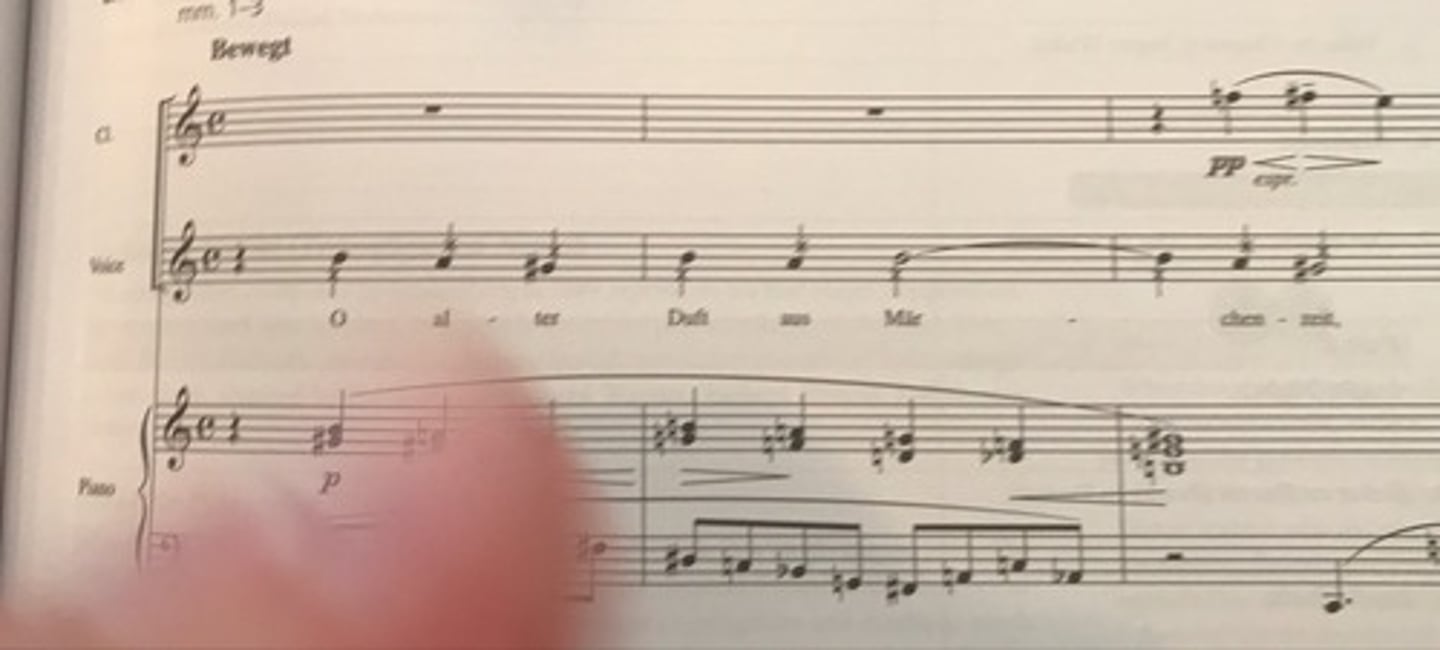
Berg, Wozzeck, act 3, scene 4: Invention on a Chord
Wozzeck returns to the edge of the pond where Marie's body lies. He searches for the knife he used to kill her. Finding it, he tosses the knife into the pond. Fearing that bathers may find it, he wades into the water hoping to retrieve it, but he drowns.
- to open the scene, a six-note repeated chord is played by woodwinds and horns; this chord recurs throughout the scene in different guises
- Sprechstimme is used effectively to underscore Wozzeck's delirium and drowning
- frenetic, angular vocal line covers an extremely wide range
- harp glissandi punctuate Wozzeck's outcries of "Morder! Morder!"
- atonal harmonies, with frequent use of chord clusters, becoming gradually slower as if to depict the sinking of the drowning body
- extended harp passage rises from the depths at mention of the "blood-soaked moon"
- text translates to, "The knife? Where is the knife?"

Berg, Wozzeck, act 3, scene 4: Invention on a Persistent Rhythm
Children are playing outside Marie's house, when one child announces that Marie is dead. They all go off to view the body, except for Marie's son. Without comprehending the news, he circles the stage on his hobby horse singing, "Hopp, hopp, hopp!"
- 12/8
- spirited melody in the style of a nursery rhyme is sung in unison by a children's chorus
- the compound meter 12/8 is well suited to depict both the hobby horse and the children's song
- after the children shout back and forth, they run off to view Marie's body
- alone on stage, Marie's osn rides his hobby horse and sings "hopp, hopp!" on a descending P4 (this is the only time in the entire opera that we hear his voice)
- undulating winds, harp, and sustained strings bring the opera to an abrupt yet poignant close

Webern, Symphony, op. 21, 2nd mvt: Theme
- Sehr ruhig (Very quite); the musical character is gentle and relaxed
- disjunct 11-measure theme
- based on transposed inversion (played by harp and French horn) and retrograde inversion (played by clarinet and bass clarinet) of the tone row
- Klangfarbenmelodie employed throughout
- resembles pointillism
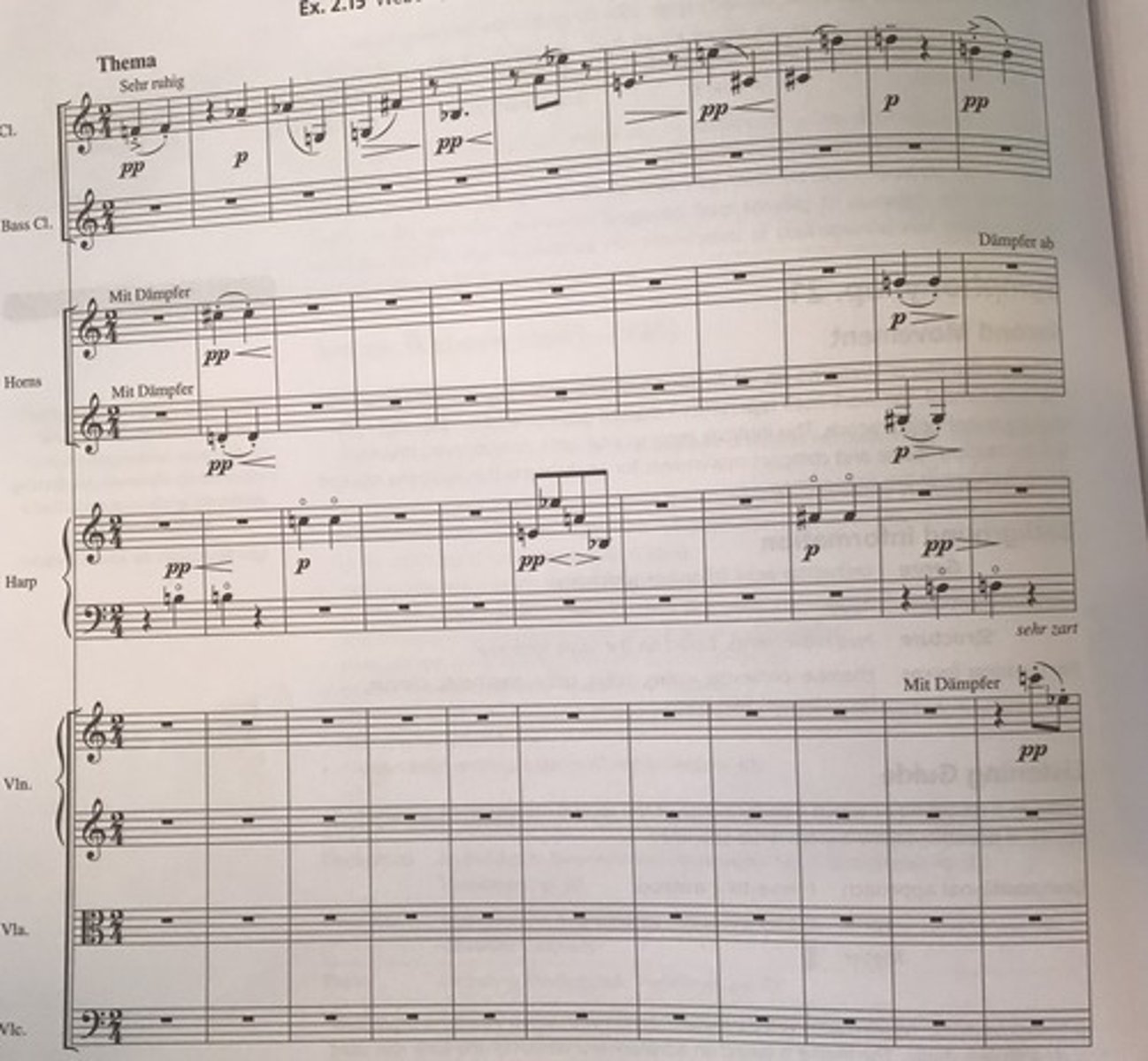
Bartok, Concerto for Orchestra, 4th mvt: Section A
- a folk-like melody in the oboe outlines a tritone
- expanded in the woodwinds accompanied by its own inversion
- meter changes frequently, imparting a lilting, asymmetrical feel to the rhythm

Bartok, Concerto for Orchestra, 4th mvt: Section B
- marked calmo and cantabile
- strikes and elegiac note with a sweeping lyrical melody in the violas
- harps punctuate the contrapuntal writing, which features canonic imitation

Bartok, Concerto for Orchestra, 4th mvt: Section C: The "Interruption"
- clarinet introduces a light-hearted melody, similar to "Da geh' ich zu Maxim" from Franz Lehar's operetta The Merry Widow; this melody is also quoted in the first movement of Shostakovich's Symphony No. 7; there are various interpretations as to Bartok's intentions with this musical quotation
- clangorous dissonances heightened by brass glissandi
- tuba states the melody with violins imitating closely with an inverted statement of the theme
- Bartok creates a rich harmonic fabric, employing variously modal, atonal, and polytonal sonorities

Bartok, Concerto for Orchestra, 4th mvt: Section A2
- woodwinds state fragments of the opening theme
- extended flute cadenza unfolds over softly sustained chords in the strings
- music dissolves forming a gentle close

Prokofiev, "The Montagues and the Capulets" from Romeo and Juliet Suite No. 2, op 64c: Section A
- ciolins and clarinets play a brusque melody rising and falling squentially through the tonic and dominant minor arpeggios
- marked pesante, the aggressive dotted-note figures impart a feeling of noble arrogance
- melody punctuated by syncopation
- the next phrase is more pungent, marked by chromatic inflections
- played marcato, its sharply angular profile covers a wide melodic span

Prokofiev, "The Montagues and the Capulets" from Romeo and Juliet Suite No. 2, op 64c: Section B
- a new melody gently outlines the ascending E minor triad, revealing its connection to the pesante theme heard earlier
- played by flutes, which are later joined by clarinets
- harp, pizzicato strings, and celesta enhance the ethereal atmosphere, which stands in marked contrast to the oppressive Capulet music that precedes and follows it
- this music accompanies Juliet's first dance at the Capulet ball with her handsome suitor, Paris; marked dolce (sweetly) it highlights her youthful innocence.

Messiaen, Quatour pour la fin du Temps, 2nd mvt: Section A
- marked Robuste, modere ("with vigor, moderate tempo")
- dissonant, crashing chords played on the piano in alternation with clarinet flourishes and aggressive string passages
- clarinet trills suggest bird calls
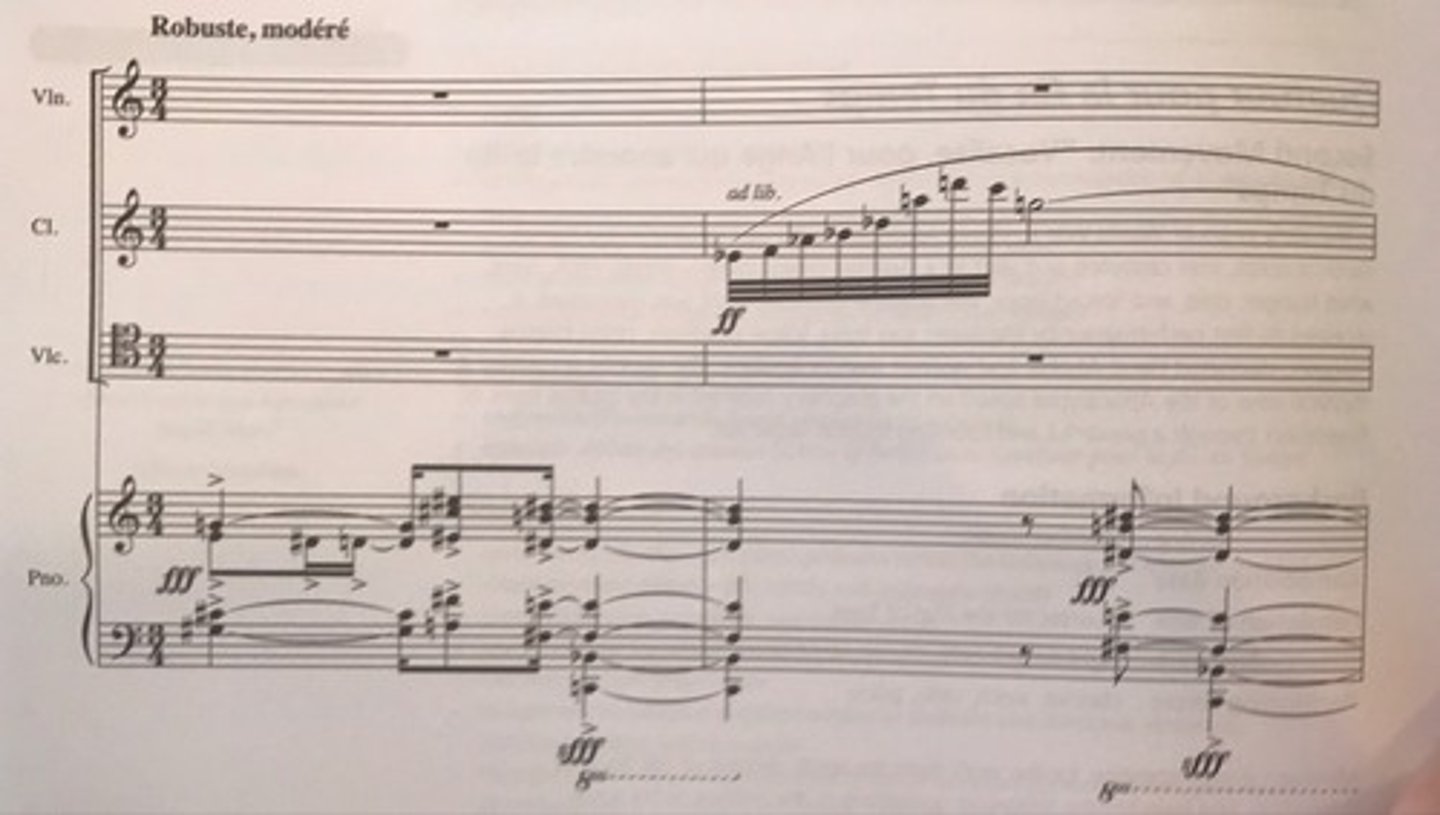
Messiaen, Quatour pour la fin du Temps, 2nd mvt: Section B
- marked Presque lent, impalpable, lointain ("Rather slow, imperceptible, distant")
- sourdine (mute) indicated for violin and cello; marked pp
- very quiet reverent and mysterious character is created
- cello and violin play a lyrical melody, two octaves apart
- piano accompanies with descending parallel-motion chords grouped in phrases consisting of eight chords; opening sixteenth rest creates a syncopated effect.
- composer refers to the continuous sixteenth notes, marked ppp as "water droplets in the rainbow"
- ends with repeated notes in a very soft dynamic (pppp in piano).
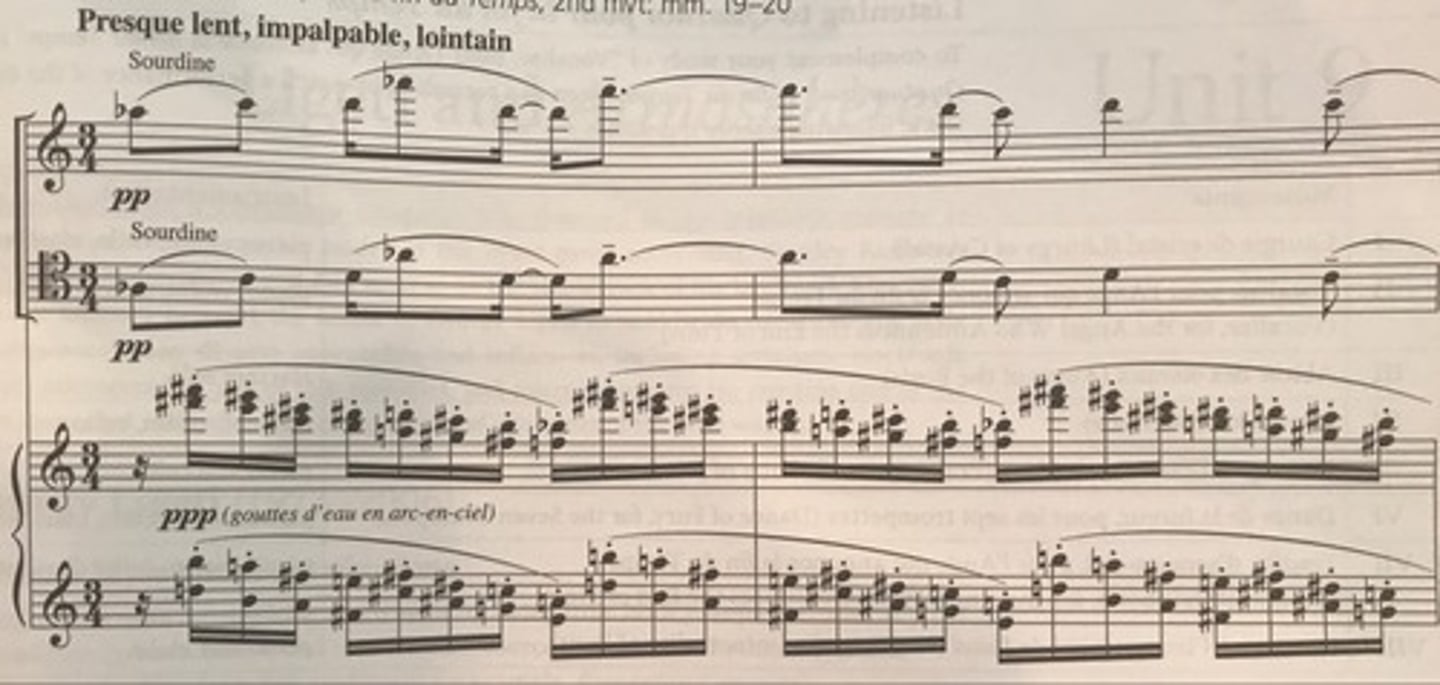
Copland, Fanfare for the Common Man: Introduction
- marked "Very Deliberately"
- opens boldly (ff) with the percussion playing three statements of the long-short-short rhythmic motive
- timpani intones a perfect fourth (F-Bb), played softer with each repetition while bass drum and tam-tam enrich the dramatic and solemn timbre

Copland, Fanfare for the Common Man: First Statement
- trumpets announce the main fanfare theme in unison
- played f
- prominent use of perfect interval leaps, a characteristic feature of fanfares
- punctuated by percussion with the long-short-short rhythmic motive
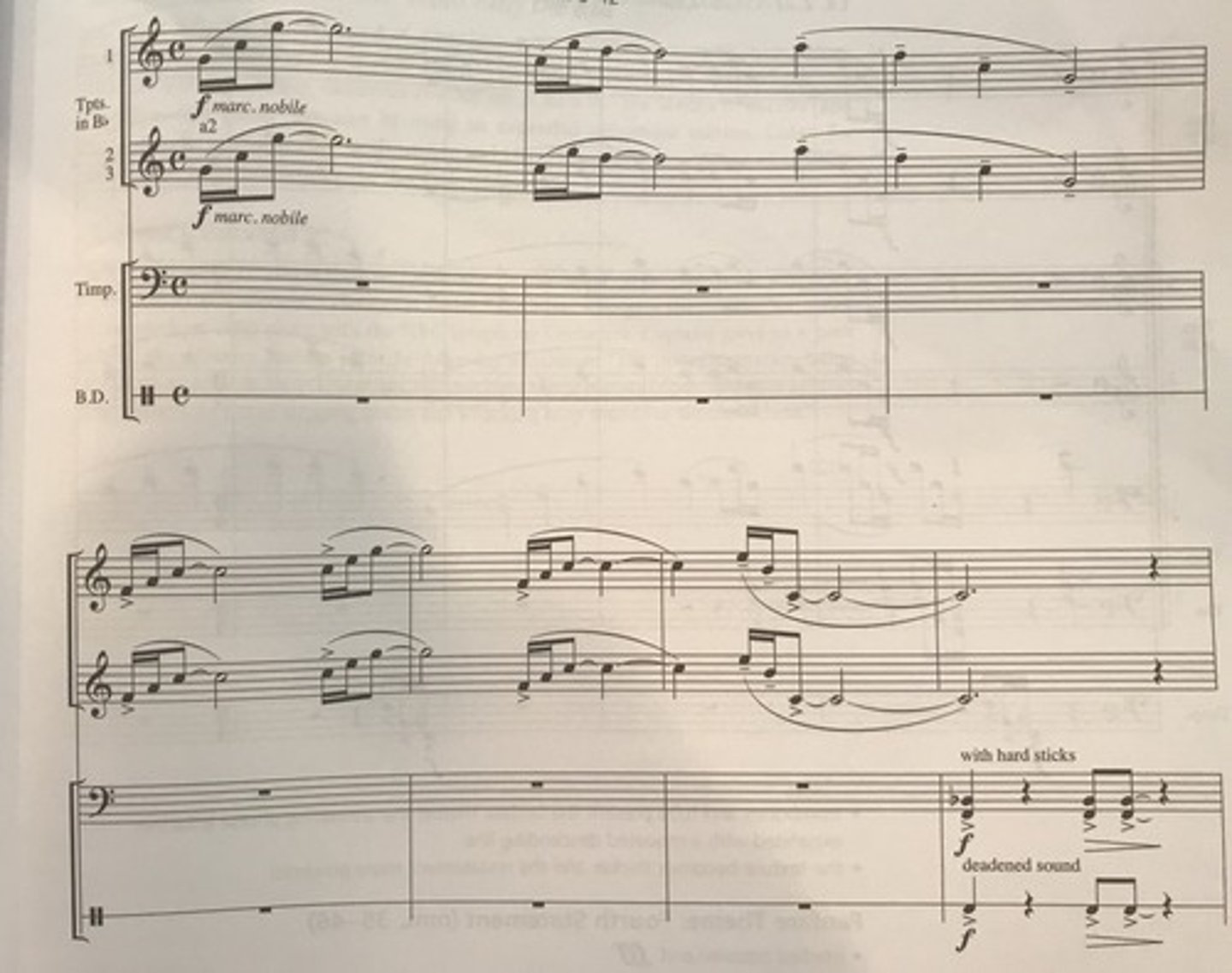
Copland, Fanfare for the Common Man: Third Statement
- trombones and tuba present the fanfare theme; the answering phrase if further expanded with repeated descending line
- the texture becomes thicker and the restatement more powerful
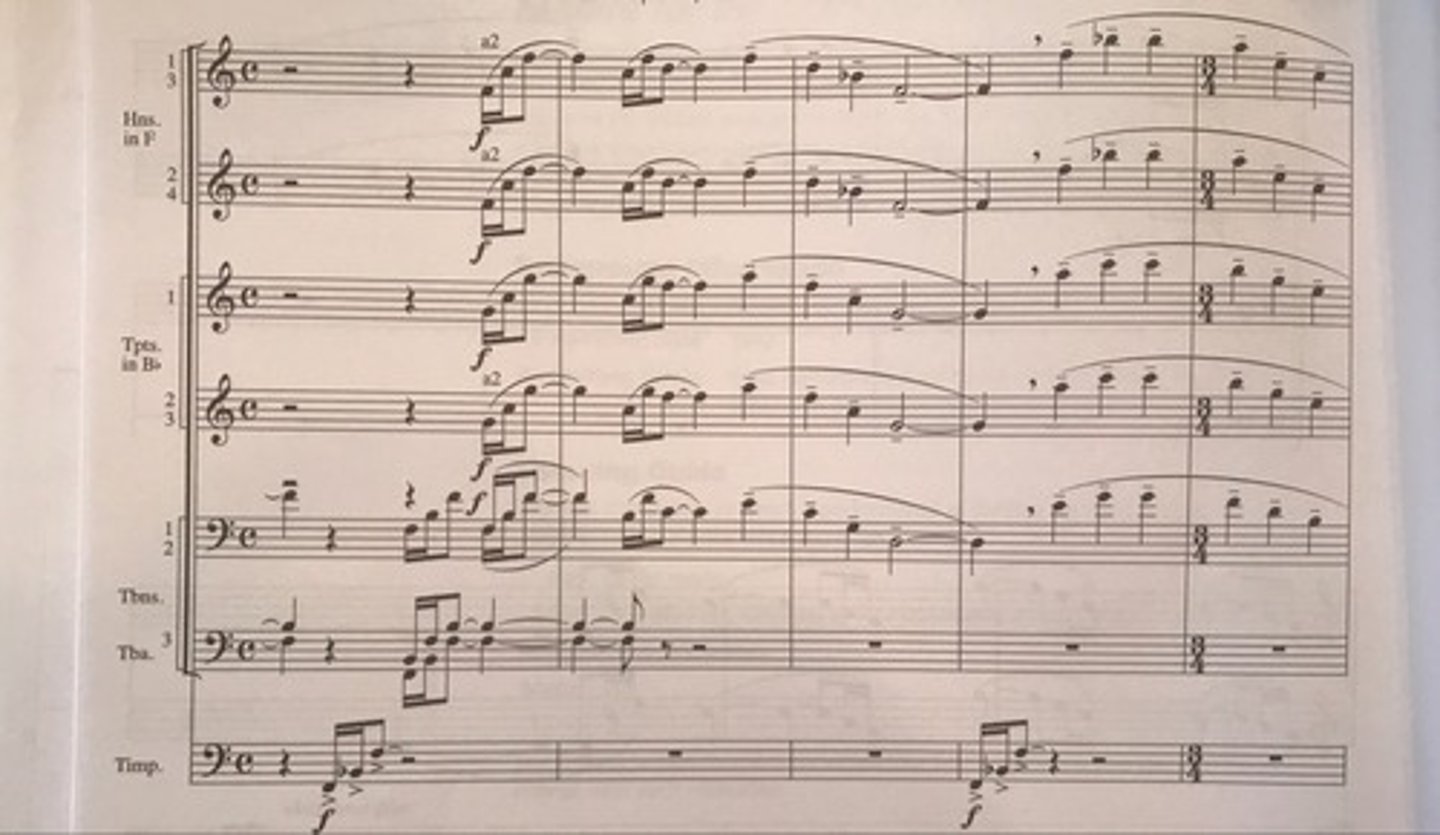
Traditional, "A la claire fontaine," Theme
- The French-Canadian folk song is a melodic source for "The Contended House".
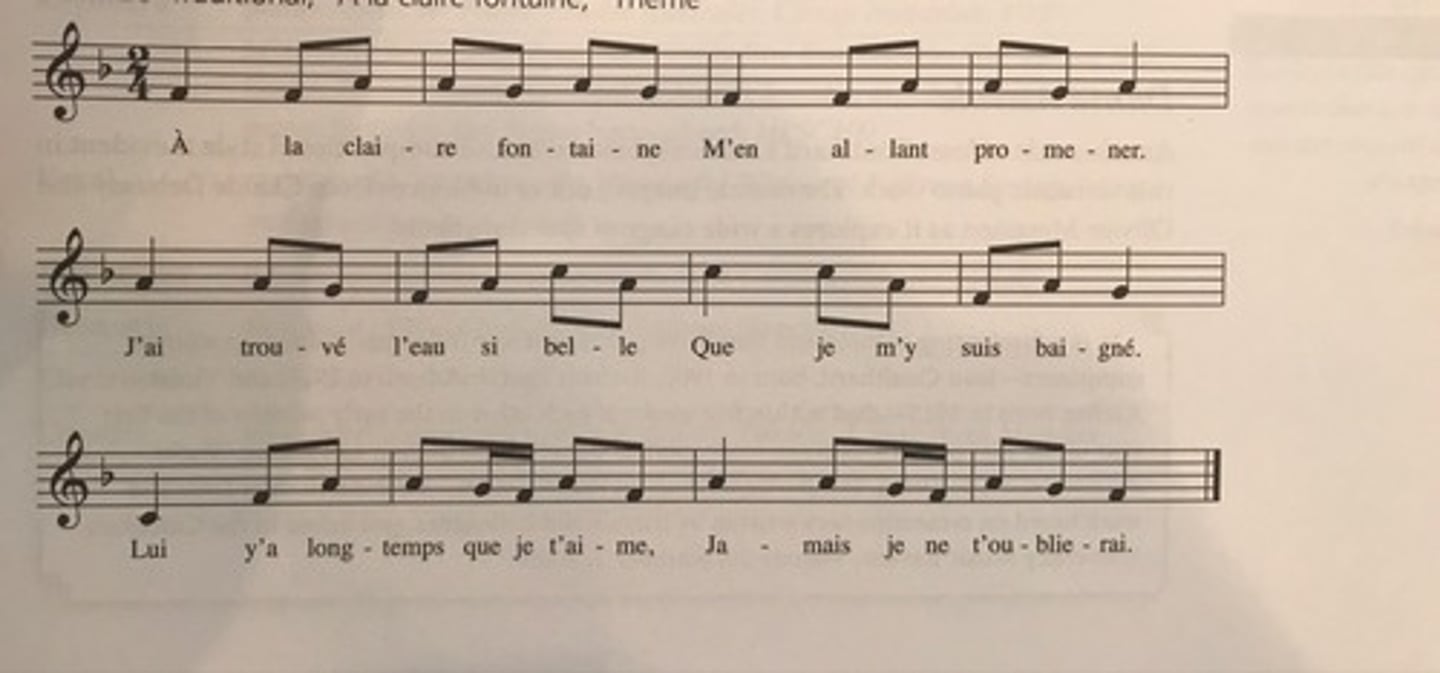
Coulthard, "The Contended House," from Canada Mosaic, oboe 1 and oboe 2
- the first quote of "A la claire fontaine," marked dolce, is played by the oboe and answered by strings
- the flute plays the second phrase of the folk melody, again answered gently by the strings
- as the music builds to a climax (but only marked mf), orchestral density increases; ascending strings and woodwinds are punctuated with woodwind trills, timpani roll, and a majestic crash of cymbals

Coulthard, "The Contended House," from Canada Mosaic, theme
- clarinets gently cascade downwards in parallel streams of thirds and sixths, punctuated delicately by the triangle
- closing measures marked morendo; strings and French horn die away.

Cage, Sonata V from Sonata and Interludes: Section A
- two-voice counterpoint centered mostly in the piano's middle range creates a strong rhythmic drive
- the material in the RH is an inversion of the LH material played in augmentation
- irregular phrase lengths (4+5+4+5) are perceived as short, ostinato=like patterns
- the prepared piano produces a rich timbral fabric: while the performer is playing the piano keys in the traditional way, the sounds emanatied form the instrument combine the usual pitched sounds with additiona percussive, non-pitches sonorities
- una corda pedal used throughout
- Section A is repeated

Cage, Sonata V from Sonata and Interludes: Section B
- the LH continutes the previous gesture but is now punctuated by abrupt silences
- the RH sustains long notes
- textural variety achieved through parallel octave motion, wide leaps, and increase use of accents
- intermittent use of the una corda pedal imparts subtle nuances
- clangorous dissonance played ff dissipates to a hushed close
- Section B repeated
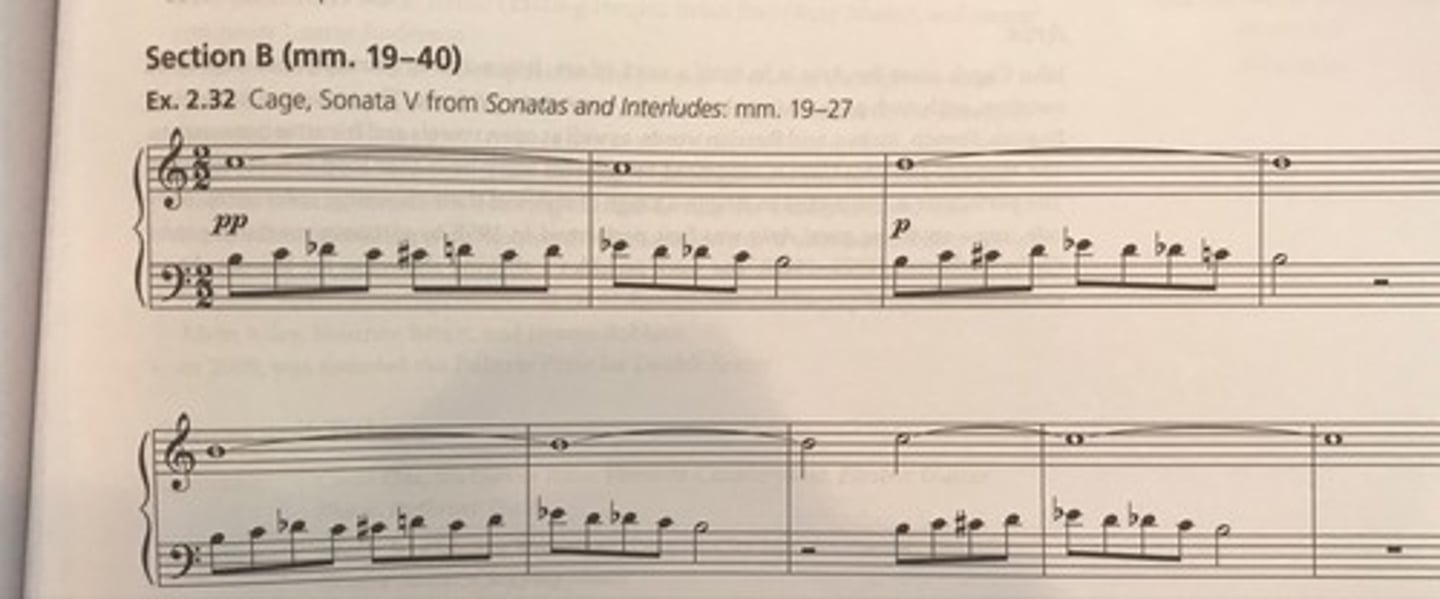
Reich, Electric Counterpoint, 2nd mvt
- begins attaca from the first movement
- a new motive establishes a gentle and lyrical character
- from the initial reduced texture, additional voices are added canonically, the building in density until all instruments are present
- shifting meters and constant syncopation are the rhythmic hallmarks
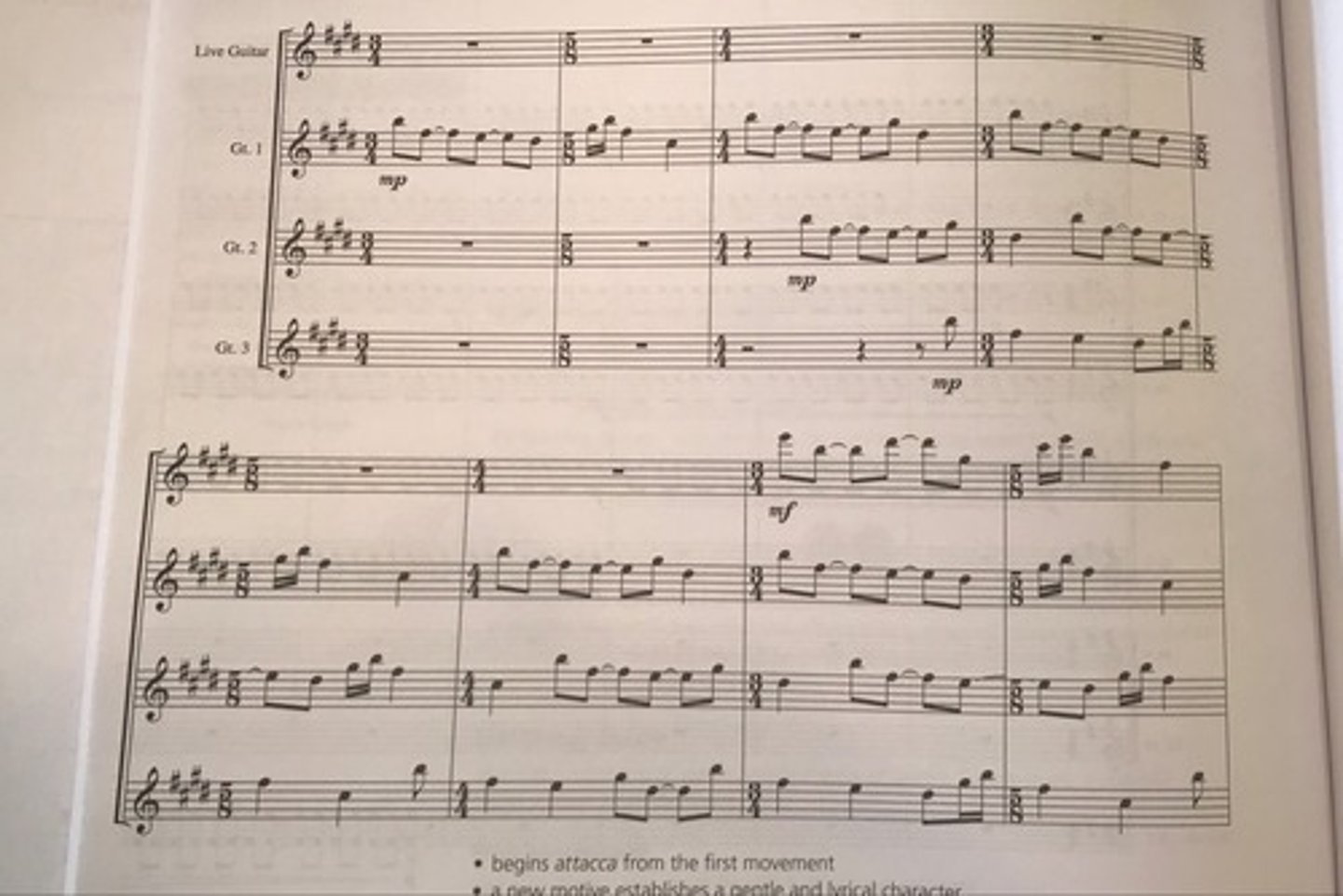
Reich, Electric Counterpoint, 3rd mvt
- attacca from previous movement
- as in previous movements, a motive established at the outset is repeated continuously
- begins with two guitars; additional instruments added, contributing to gradual building of sound and texture
- as in previous movements, a motive established at the outset is repeated continuously
- strummed chords enter in m.36, creating a new texture and rhythmic groove
- the relentless energy is maintained until the final notes
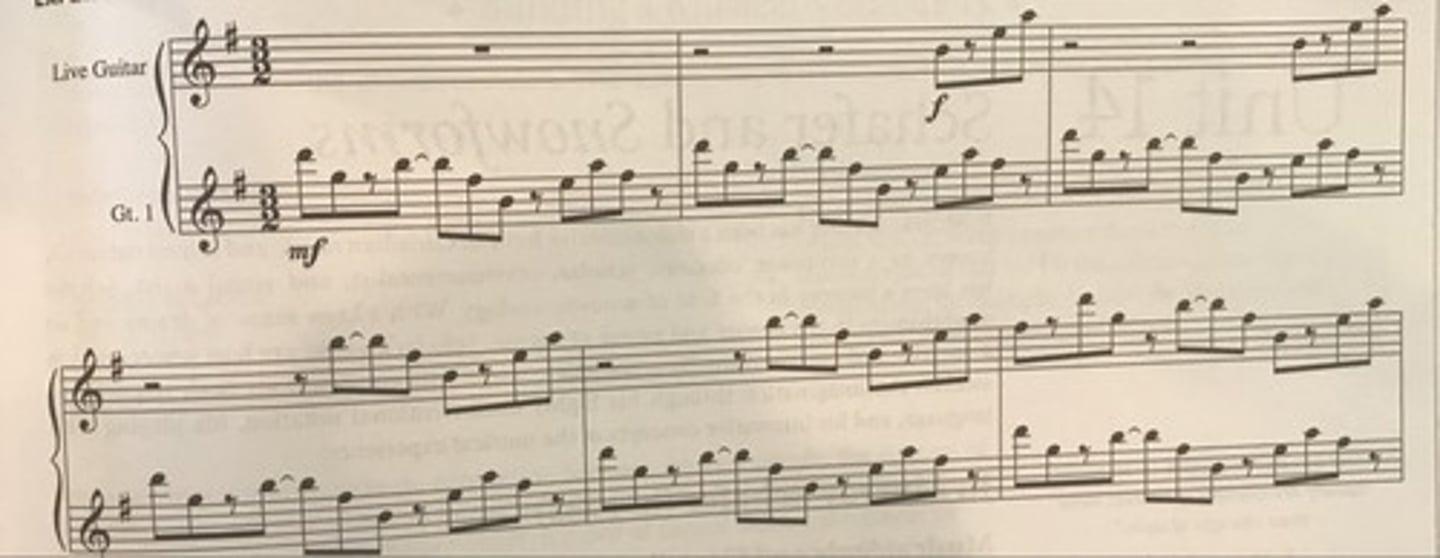
Mahler, Symphony No. 4 in G Major, 4th mvt: Verse 1
- word-painting: mezzo-soprano reaches sublimely for the high G, depicting Saint Peter in heaven
- the simple descending line is accompanied homorhythmically in a chorale-like style by flutes, horns, and harp; parallel chord streams evoke a reverent, solemn sound, reminiscent of medieval church music.

Webern, Tone Row from Symphony, op. 21, 2nd mvt

Prokofiev, "The Montagues and the Capulets" from Romeo and Juliet Suite No. 2, op. 64c: Section A
- a new theme in D minor heralds the arrival of Lord Capulet and Tybalt (Juliet's cousin and heir to Lord Capulet)
- the stepwise melody traces the ascending and descending natural minor scale
- played f by French horns in octaves
- underscored by the incessant dotted note figure heard earlier
- music passes through A minor and F minor before returning to E minor, demonstrating Prokofiev's use of abrupt chromatic modulations
- section ends with an emphatic authentic cadence.
-

R. Schumann, "Florestan"
- dissonance gives way to fleeting consonance; Schumann eases the tension briefly
- the same quotation recurs a few measures later
= the opening melody returns in Bb major; a chromatically ascending line in an inner voice maintains the undercurrent of tension

Schafer, Snowforms, p. 3
- singers evoke that sense of austere peace that a northern snowscape can create by improvising, sliding between pitches, and humming chord clusters or stark, open intervals; the resultant soundscape is stirringly peaceful
- graphic notation is used with pitches (note names) written close to the wavy lines:
- an abrupt curve in the notation suggests that the lower point of the line gets a short note
- a more continuous curve suggests a lingering and slow glissando
- time durations are marked in the score as suggestions/guidelines for the conductor
- the thickening or thinning of a graphic curve implies a slight crescendo or diminuendo
- throughout the work, mellifluous vowel sounds contrast with softly percussive consonants
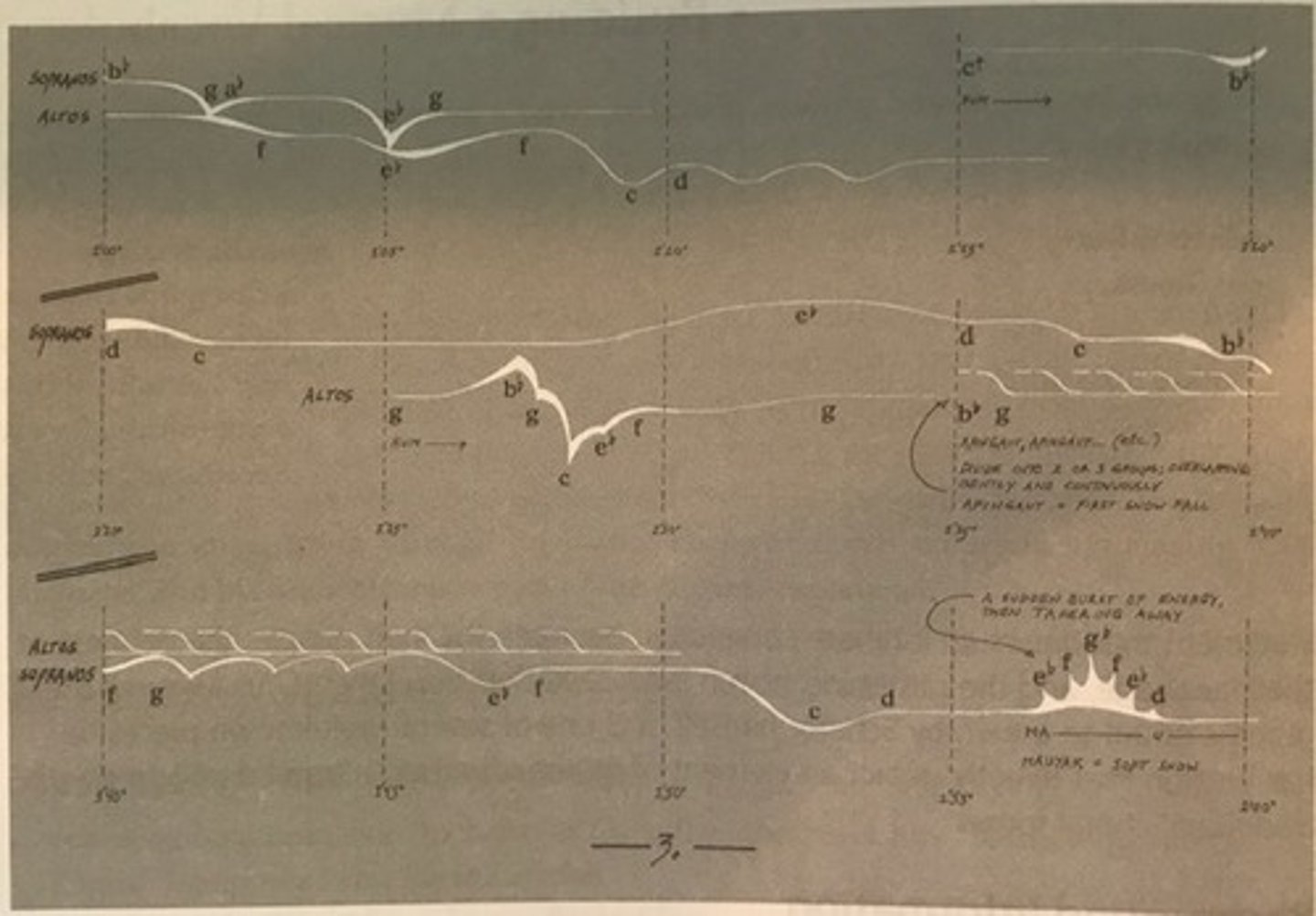
Reich, Electric Counterpoint, 1st mvt
- relentlessly steady tempo and pulsation of repeated notes with uninterrupted momentum
- wave-like patterns of crescendo and diminuendo shape the material
- at m. 110, delicate, dance-like syncopated motives emerge from the initial density, now within a more sparse texture; the sudden contrast is striking to the listener as the repeated notes abate
- repeated notes return and are joined and layered by seconds, thirds, and triads, while the syncopated motive continues
- and extended crescendo leads to fuller harmonic sonorities
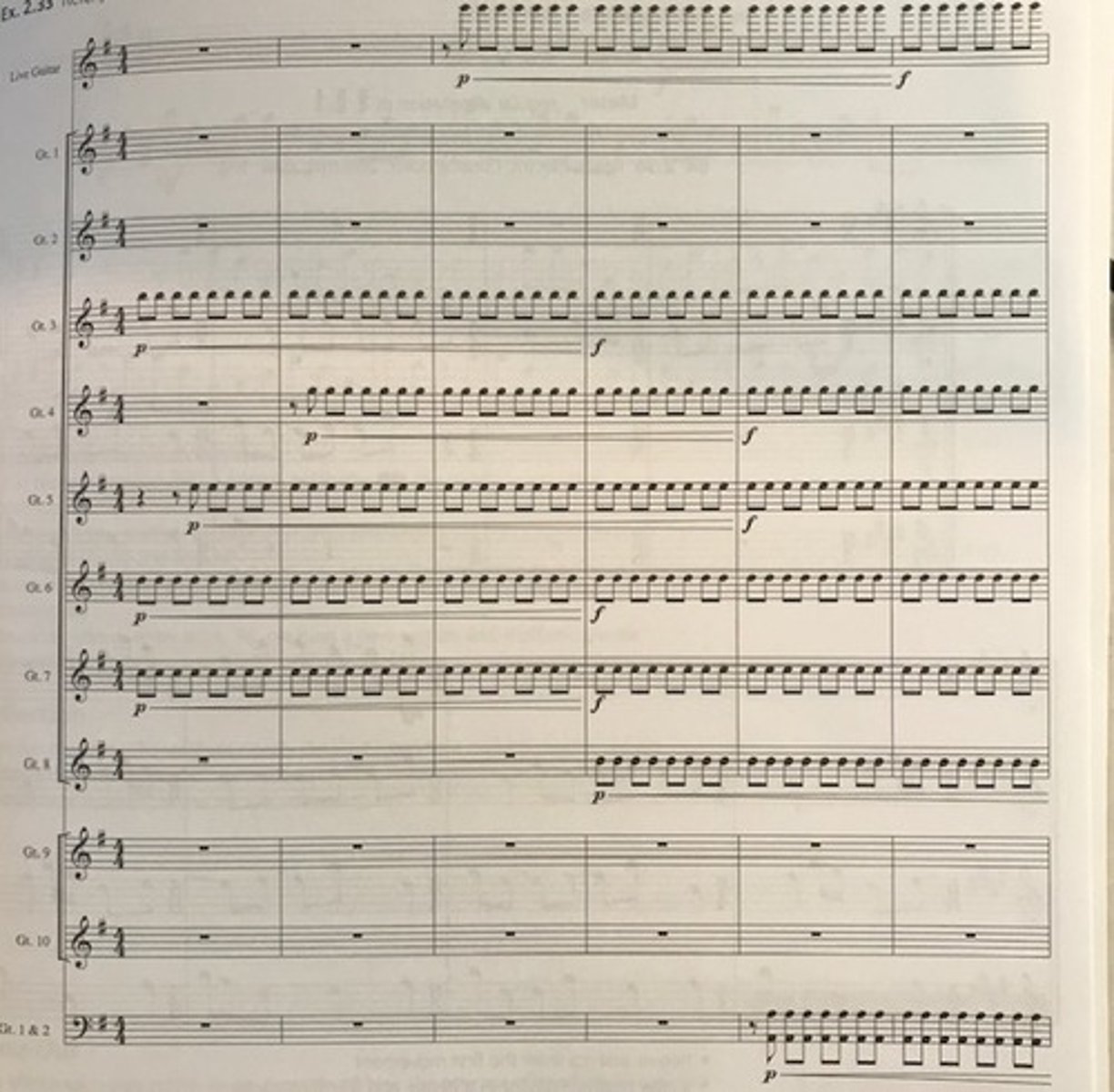
Mendelssohn, Violin Concerto in E Minor, op. 64, 1st mvt: cadenza
- features fragments of the opening motive of the first theme
- technical challenges include rapid string crossing, high-pitched harmonics, and spirited spiccato
- the unconventional placement of the cadenza at the end of the development serves to expand and dramatically highlight the dominant preparation, providing a seamless link into the recapitulation
